#(or literally anything that references any traits I might have picked up from my source)
Text
why Kaminari Denki is not the U.A. traitor (and why the traitor is actually Hagakure)
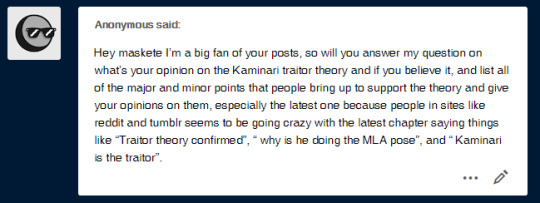
thank you, anon! okay first off, my opinion of the Kaminari Traitor Theory is: nah, he ain’t. but as requested, I will break this down and refute the various arguments point by point.
this is a big compilation of various “Kaminari is the traitor” posts from 4chan (general warning btw for 4chan being 4chan), which I got from this reddit thread. some of these are clearly shitposts, but on the whole it seems fairly comprehensive, so I’m gonna use this as my primary source for theory arguments. if there are any major arguments for this theory that I missed please let me know.
also! a huge part of the reason why I don’t subscribe to this theory is that I am 1000% sure that Hagakure is the actual traitor. so the second half of this post will consist of a detailed explanation as to why I’m all-in on that theory to the point of dismissing any and all other theories. I feel like that’s worth clarifying a bit more.
so! here goes.
“his proto design is that of a villain”
lol I’m trying to think of how to put this diplomatically. this is something I see a lot, people using Horikoshi’s prototype sketches and notes as evidence for various theories. the thing is, this is shaky ground at best. there’s a reason why these are proto designs and not the final product. Deku’s proto design had emo kid hair, and proto!Katsuki was an obnoxious prep school kid lol. plans change, and thank fucking god for that tbh.
but that aside, “he looks like a villain” is not in any way a solid argument to begin with. Horikoshi has made a point in the actual story of showing that people’s preconceived notions of what heroes and villains “should” look and behave like doesn’t always line up with reality. and in this case we’re not even basing it on behavior, but solely on how he looks, which is really kind of discriminatory. by that logic, one could look at, say, Shouji, and be all, “well he’s clearly the traitor.” just because someone looks scary at first glance doesn’t mean they actually are. all in all, I don’t buy it.
“Kaminari is the only one who could have told the villains where the camping trip was being held since he’s pretty much a walking GPS”
I present to you a panel from chapter 83:
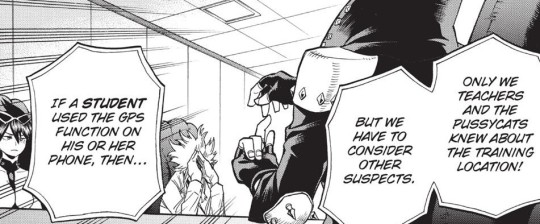
literally any one of the students could have used their phone’s GPS to pinpoint their location and send it to the villains. they weren’t on any kind of communications lockdown, and even if they were, there was no practical way to enforce it. so this argument doesn’t really hold water for me. even if Kami’s quirk did work that way, which we don’t really have evidence of aside from one weird line in the USJ arc that has never since been expanded on, that doesn’t really work as evidence of him being the traitor when there are 39 other kids who could have done the exact same thing without a quirk.
“his dumbness is fake”
this is honestly the one aspect of this theory that I least understand. the thing is, this isn’t a theory. this is a what-if. it’s as if it occurred to someone one day, “lol what if he was just faking” and then this entire elaborate conspiracy headcanon was built up around that and eventually evolved into what we have today. this just doesn’t make sense to me at all. is there any evidence of him actually faking it? I feel like people just went “omg that would be such a cool twist” and then started arguing why it could be canon.
anyways I personally think Kaminari is 100% certified organic dumbass, and frankly I love him for that. where is the respect for the dumbasses of the world. Kaminari is still a great character even if he’s not secretly a JUST AS PLANNED double agent. you don’t need to make him evil for him to be interesting.
“look at his sneering face here, though”
okay yeah but hear me out: he’s a little shithead, lol. I mean, do you also think Bakugou is the traitor or.
“I edited this picture to make him look more evil, look”
okay??? lol, what. I think we can just move right along from this one.
“he didn’t bother with a costume, this must mean he doesn’t need help controlling his ability”
this I don’t get at all. a lot of the kids went into hero school not having a clear idea of what kind of costume features would best suit their quirks. that’s only natural; they’re still inexperienced. it is in no way any kind of indicator of any deception on their part. Kaminari is extremely powerful, but until recently he hasn’t had the guidance he needed to help him figure out how to harness that power better. and seeing as he has now made several modifications to his costume since starting at U.A., this argument is out of date.
“it’s scary how much traitor kaminari would make sense”
a lot of these really are just shitposts, huh? maybe I should have picked a better source. but just, like. what even is the logic here? “if he’s actually not stupid THEN HE MUST BE EVIL”? I really am trying to give this theory a fair shake you guys, even though it probably doesn’t seem that way. but this is just leap after leap. I keep thinking that I must have missed something crucial but as far as I can tell this is it.
“Monoma’s gonna copy his quirk and figure it out”
I do want to see Monoma copy his quirk, but only because seeing him go all “wheeeey” would be absolutely amazing tbh.
“reminder that kaminari thought stain was cool”
this one is actually a reasonable point. but listen, you have to keep in mind that Kaminari is a sixteen-year-old boy who gets easily swept up in the latest crazes and memes and fads. he’s naturally curious, and very open-minded and accepting, even when he perhaps shouldn’t be. but it’s as much a strength as it is a weakness, if not more so. those same traits make him the friendliest member of class 1-A (with the possible exception of Kirishima), allowing him to get along well even with a sentient cactus like Bakugou, and to stubbornly befriend Shinsou all of fifteen minutes after Shinsou announced that he wasn’t there to make friends lmao. he’s very unprejudiced, and when you put that together with how excitable he is, you can see how that might make him a bit more susceptible to getting caught up in stuff like the Stain hype train. it doesn’t make him evil. hell, even Deku had a kind of begrudging respect for Stain. I personally can’t stand Stain at all so I don’t get it myself lol, but it seems to be canon that he had a real charisma which many people were swayed by even if they didn’t agree with his ideals.
“>hanging wrist watches on the wall - Who the hell does this”
you know what that’s a fair point too.
“his room is tacky and shows no personality”
okay in seriousness this is barely worth addressing because it’s so far of a reach, but fine. the thing is, Kaminari’s core personality is that of a typical teenage boy. that’s his role in the class. he’s just a normal guy, because you need to have some normal people around to balance out this cast of extravagant weirdos. and anyways, if we’re accusing people of being evil simply because their rooms lack personality, Ojiro and Shouji’s rooms are right. there. I’m just saying.
“he was in remedial too [on the school trip]. avoiding combat”
so were Sero, Kirishima, Mina, Satou, and Monoma. what’s more, they didn’t know that the remedial kids were going to be barred from participating in the test of courage. most of them were devastated to realize that lol. anyways so yeah this isn’t really proof of anything.
“[the night] before the attack Kaminari is clearly missing”
this is referring to this panel from chapter 75:
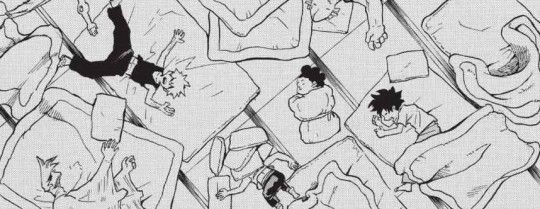
however, there’s actually a whole chapter in the second light novel about Iida going around in the middle of the night checking on his sleeping classmates (which is actually very sweet) while also trying to find his glasses, and said chapter establishes that Iida is in fact the one missing in this scene. because he’s wandering around tucking people in and shit. Kaminari is actually the one under the pile of pillows.
anyways, this is getting long and I haven’t even gotten into the real meat of this post yet, so I’ll just address a couple of the remaining arguments real quick.
but if he’s really that stupid how did he get into U.A.” - he studied!!! also he’s not really that stupid! he can be very bright, he’s just easily distracted.
L pose – as others have pointed out, this...

...is very likely just a variation of his finger gun pose, as seen here:

but even if it’s not, my rebuttal for the Stain argument applies here as well. my boy loves his memes. this would have been right in the midst of all the Deika City coverage, and the PLF probably took the opportunity to throw a few poses in there. it’s probably the trendy thing on Instagram right now. in any case, what it is not is proof that Kaminari is the person who broke into the U.A. offices and stole the staff schedule in order to facilitate the League’s planned invasion of USJ. nor is it proof of Kaminari being the one who gave away the training camp’s location.
and segueing into the second part of this post now, this, IMO, is what so many of these traitor theories are missing. if you’re trying to identify who the U.A. traitor is, these are the two incidents you need to look at. I feel like a lot of people get swept up in what-if speculation, and forget what sparked this whole notion of there being a mole at U.A. in the first place. it’s specifically because of these two attacks, which could not have been planned without the assistance of an inside person providing information to the League from within UA. therefore, if we’re trying to identify who the traitor is, these are the only two questions we actually have to answer:
who, if anyone, had the opportunity to steal the staff schedule during Shigaraki’s break-in in chapter 12, and
who was it that gave away the training camp’s location and allowed Dabi and co. to invade and kidnap Bakugou?
that’s it. this, IMO, is what the focus should be on. and here’s the thing: while we still don’t have a definitive answer for the second question, we do have an answer for the first, and Horikoshi gave it to us all the way back in that same chapter.
but before I get to that, let’s back up and revisit that memorable incident. recall, if you will, the events that took place on the day of the break-in. class 1-A voted on a class president, and afterwards, during their lunch period, the security alarm went off as a result of Tomura doing this to the door and allowing the press to swarm the school:
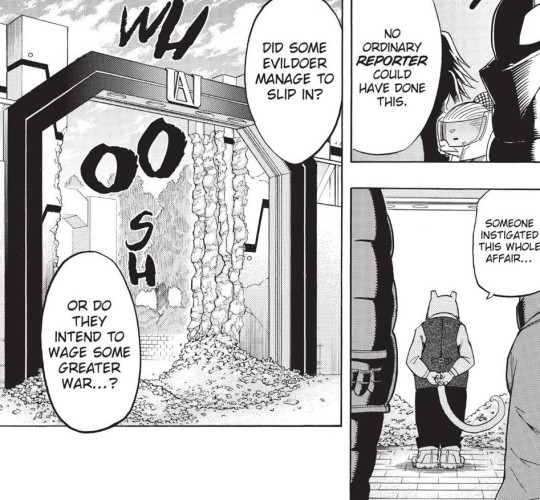
initially, Rat Principal speculates as to whether a villain might have taken the opportunity to sneak in. but given the later incident at the training camp, as Present Mic rightly points out, it’s far more likely that there is a traitor in their midst instead. someone who had both the means and opportunity to take advantage of the chaos caused by the press, and somehow steal a copy of the staff schedule from right under U.A.’s nose.

given that this same person is almost certainly the one who later on gave the training camp info to the villains as well, this narrows down the field of potential suspects to either one of the teachers, or a student from class 1-A or 1-B. obviously if it’s a teacher then it could be any one of them, so there’s really no point in trying to narrow it down. the same goes for 1-B since we’re not even introduced to them until the following arc and we have no idea what they were doing during this incident. so for now, the question becomes: which, if any of the class 1-A kids had the opportunity to steal the schedule during chapter 12?
and for the answer, we need only revisit the class president voting records:
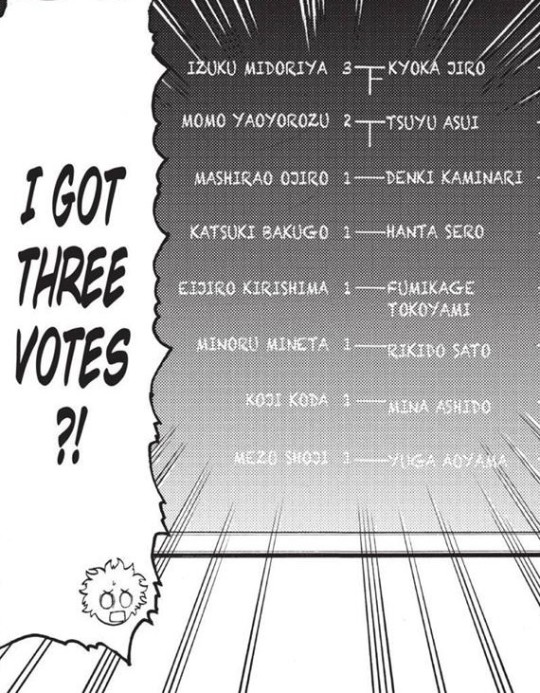
incidentally, this is something I can’t take credit for, because it was Viz’s translator Caleb Cook who originally pointed it out on his Twitter. but anyways. just in case this isn’t clear, the results are as following:
3 votes - Deku (himself, Ochako, and Iida)
2 votes - Yaomomo (herself, and Shouto)
1 vote - Jirou, Tsuyu, Ojiro, Kaminari, Bakugou, Sero, Kirishima, Tokoyami, Mineta, Satou, Kouda, Mina, Shouji, and Aoyama
for anyone doing the math, that is... nineteen votes.
curious, for a class consisting of twenty kids. and downright suspicious given the events that take place less than an hour later. assuming that each student voted for him or herself as implied, what this means is that every kid in class 1-A is accounted for on the day of the break-in, except one. and it’s not Kaminari.
it’s Hagakure.
Hagakure is not featured in any of the panels before or after the vote, either. true, she’s invisible, but she should still be wearing her uniform at the very least. but she is very distinctively the sole 1-A student unaccounted for during this chapter. Hagakure, whose quirk is invisibility. Hagakure, who could have easily slipped into the teacher’s office during the press onslaught and taken a copy of the schedule unnoticed. Hagakure, who is also one of only two people (the other being Aoyama) whose whereabouts are also unverified during the subsequent attack:
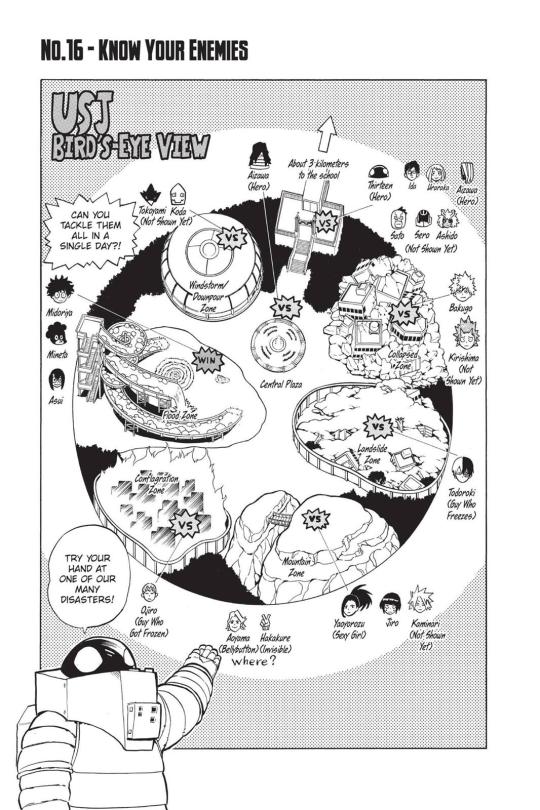
now this is where it gets really interesting. why would Hagakure’s location be deliberately withheld? especially since later on she says that she was actually with Todoroki the whole time:
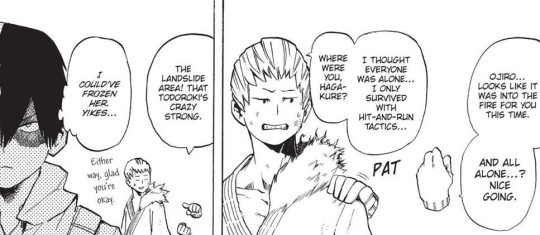
unlike Aoyama, whose whereabouts remain a mystery because He Is Just Like That, Hagakure freely discloses her own whereabouts. the thing is though, if it wasn’t actually a secret, then why did Horikoshi go out of his way to omit it in the first place? there are other characters whose locations we only know because Horikoshi put them on the map. specifically Tokoyami and Kouda, who are never actually shown battling once they get warped away (at least not in the manga). yet despite this, their whereabouts aren’t a secret. it’s a deliberate choice by Horikoshi to not confirm where Hagakure actually is, and coming on the heels of her also being conspicuously MIA in chapter 12, this IMO is a huge red flag.
anyway, so now let’s fast forward to the training camp arc. now here, we do know where Hagakure ends up. specifically, she gets KOed by the gas along with Jirou. this makes her one of only two U.A. students who are not actually involved in the fighting either at the forest, or back at the lodge with Vlad. at first glance, that might appear to make her less suspicious. and it’s true that unlike the USJ arc, there is no evidence here that directly ties Hagakure to this particular invasion (though the same is true for pretty much everyone else as well). however, there are two things I would like to point out. the first is Hagakure and Jirou’s position in the test of courage lineup:

directly behind Todoroki and Bakugou (a.k.a. the League’s target). this would have put her in a good position to signal to the League when to attack. note that the attack didn’t commence until Baku and Todo had reached the midpoint of the trail, which results in their decision to press forward through the forest rather than turning back toward the start.
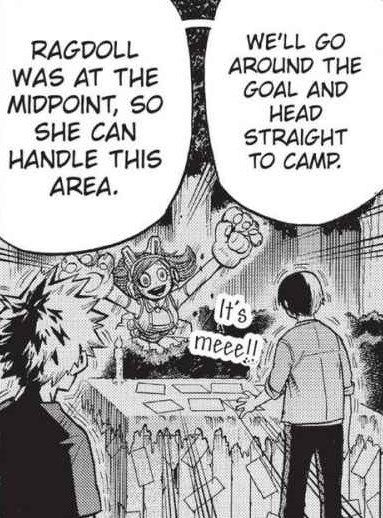
this is suspiciously good timing on the League’s part. it’s not confirmed they knew exactly when to strike -- they could have just gotten lucky -- but it’s something worth taking note of.
and the second thing is that being so close to the League’s target would have made it difficult for Hagakure to escape without having to fight the League. and since she wasn’t alone, she couldn’t just run off and hide like during USJ. so it may be that she made the deliberate choice to let the poison gas take the two of them out instead, especially if she knew in advance that it wouldn’t actually be lethal. this gives her an alibi for the attack without putting her in the awkward position of potentially having to fight her own allies. all in all it’s making the best of a tricky situation.
lastly, here’s the thing that really clinches the whole theory for me, and it takes place a couple of days later. now remember, the purpose of this whole attack was for the League to kidnap Bakugou. they go to all that trouble, even losing three of their own members in the process. and what happens afterwards, barely two days later? the heroes track down the villains using Momo’s homing device and Naomasa’s fortuitous tip, and are able to get Bakugou back, albeit at great cost. all of that meticulous planning, only for the League to end up on the run, and with Tomura’s mentor taken captive to boot.
this seems like a huge oversight on behalf of the U.A. traitor if they knew about the heroes’ attack and didn’t think to warn the League. and the thing is, we know for a fact that every single member of class 1-A did know in advance, thanks to Kirishima and Shouto. every member that is, except two.
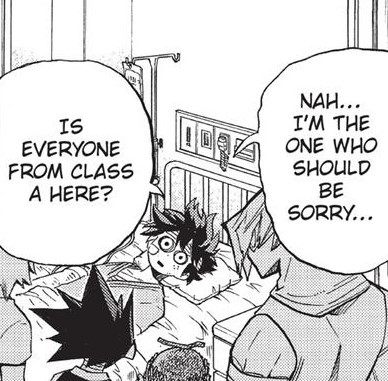

hmmm.
so, to reiterate. Hagakure Tooru:
has no alibi for the incident in chapter 12 during which someone stole the staff schedule as confirmed by Kurogiri in chapter 13
has no confirmed alibi for the USJ invasion
had the means and opportunity to pass along the training camp location to the villains, assuming she had a phone with GPS
is one of only two 1-A students who did not know that the heroes had tracked the villains’ location, and thus would not have been able to pass along that vital bit of info. we know that the villains were caught unawares by the heroes’ raid, so this is huge
so that’s three incidents (not counting the training camp location which admittedly anyone could have done) in which Hagakure is singled out as one of only a handful of people with no alibi during a critical moment. now granted, there are a handful of other candidates who could possibly fall under suspicion for same reasons. Aoyama’s whereabouts are also unknown during the USJ invasion, and Jirou was also knocked out during the training camp attack. however, Hagakure is the only one who lacks an alibi for all three incidents. and, crucially, she is the sole 1-A student who did not vote in the class president election, something which is never explained or even brought up but which is hidden in plain sight.
for these reasons, I pretty much have to conclude that Hagakure is the U.A. traitor. it just lines up. and for me, the difference between the Hagakure theory and the Kaminari theory is that the evidence for the former is based on actual events in the canon, whereas the Kami theory seems to mostly just be speculation about whether or not he’s secretly evil. and look, I have no idea whether or not Hagakure is evil. I have no clue why she’d be doing this. she seems nice (although it’s worth pointing out that we have no idea what she actually looks like, who her family is, or even how old she really is for that matter. her quirk is awfully convenient for being a spy). motive is definitely a big question mark here. but the fact remains that all of the evidence we have thus far points to one candidate, and that’s her.
anyways! so that’s the end of my post about the Kaminari traitor theory, I guess! basically, he is not the traitor for many reasons, but the most compelling one is that the actual traitor has already been confirmed in my book. anyhoo, this plot has more or less been on hold since chapter 98, so it’s been quite a while since we’ve had much to speak of in terms of new evidence. but as of 242 it looks like things may finally be on the move again, so that’s exciting. regardless of my opinion on the Kami theory, I’m excited that people are talking about this again, and I really can’t wait to see how things develop from here.
#bnha#boku no hero academia#kaminari denki#hagakure tooru#bnha meta#bnha spoilers#mha spoilers#makeste reads bnha#asks#anon asks#bnha theory#u.a. traitor#traitor!hagakure#hagakure traitor theory
273 notes
·
View notes
Text
Dhawan!Master Character Analysis
A look at Confused motivations, externalized anger, performance, self-destruction, boredom, and trauma
Confused Motivations:
Something I find interesting is that The Master’s motivations are not understood by himself. He professes it’s because he is angry that The Doctor is a key part of who he is and the “specialness” being The Timeless child gives her, but this is no way the whole story.
A more complete read of the motivations:
A biological concrete aspect has been added to the vacillations of feeling less than and better than The Doctor causing anger.
A compulsive need to control The Doctor and make them the same by putting them on the same “level”
Anger at being even more of a tool and creation of the Time Lords and loss of autonomy & control thereof.
Anger that they hurt The Doctor
Boredom, apathy, impulse control deficits and general control issues informed by trauma.
I doubt he is aware of all of these layers, and I believe The Doctor in the story and us as spectators will choose the one they believe is the “real” reason, but it was never just one. The Master flattens these motivations and explains it to The Doctor as almost all disdain for her, and blind rage, both actively in his emotions, and subconsciously to himself.
We know The Master has been used by the Time Lords their whole life (longer if the child in the flashbacks is Baby!Master) and has their autonomy stripped to be used as a tool of the aristocracy. He is dealing with having the Time Lords who have taken his autonomy directly on a physical level via The Doctor’s DNA. Just like the drums and resurrection during The Time War, we have direct physical meddling by the high council.
The Master has always felt that The Doctor and he are the same, that she is better than him, and that he is better than her in turn. This vacillating perception of her and their dynamic with each other is something we can see tracing through their relationship. This comes into play where they are used as foils and mirrors to each other. The Doctor Pointing this function of being the same while opposed to each other:
Twelve: “He's the only person that I've ever met who's even remotely like me.”
Bill: “So more than anything you want her to be good?
An interesting way we can see this change how they refer to each other sometimes using the present tense and past tense of the word friend.
Ten: “A friend, At first” [Ten spends most of the time focused on them being ‘the last’ over a real relationship, but offer a hand]
Thirteen: “The Master was one of my oldest friends. We went very different ways.” [Thirteen is intensely emotional about the master, more so then we have seen her at almost any other point, but shows mostly anger and exhaustion]
Twelve: “Of course she's not dead. She's a friend of mine. I may have fiddled with your wiring a little bit.” [Both Missy and Twelve focus heavily on their friendship and fall heavily on their intimate history]
The Master also changes the description of their relationship
Missy:“friendship older than your civilization, and infinitely more complex.”
Dhawan!Master: “I'm her best enemy.”
We see how the Fifth Doctor has an almost apathy to The Master, Seven takes the time to give him a proper burial, Ten and Twelve both seek out their respective Masters dreading the loss. The Master also does this being open about wanting attention, playing lower stakes dreams, being truly murderous, and abjectly cruel. The Master's self-perception shits as well; playing god on Gallifrey, making a personal army, putting her on a pedestal, dragging her down, and a suicidal streak. I think this helps illustrate the behaviour throughout the whole season.
The Doctor and The Master compulsively try and get the other’s attention. The obsession is something pointed out by multiple other characters namely; The Brig, Jo Grant, and The Rani. We can see this in him taking the time to play at being O and in how even when he yells about wanting her dead he also always knows she will live why else would he leave a note for her that would show when she got to Gallifrey. The Master will get none of the sought after catharsis and compulsion to involve The Doctor if she actually died. In their Eiffel Tower confrontation;
Doctor: “When does all this stop for you? The games, the betrayals, the killing?”
Master: “Why would it stop? I mean, how else would I get your attention”
His involvement this whole season is only about The Doctor, even the side operations of working with the baddie on earth, committing genocide and paling with the CyberMen are all about The Doctor and his need to exert control over both of their lives.
The Master is angry that The Doctor was hurt. The Master has always had a kind of “Only I can hurt The Doctor” mentality. And considering he knows how it feels to be used and manipulated, I don’t think he wants The Doctor to suffer in that manner by the Time Lords. I don’t think it’s contradictory to want to hurt everyone else and also be angry The Doctor was hurt. Because of the obsessive thoughts around The Doctor, it would alter the thought patterns, The Master is not working based on logic.
A real empathetic connection to The Doctor is present in the way someone who is in a toxic relationship will have. This goes both ways we can see this in the way they have all of these periods of differing extreme emotions, especially if you look at Simm->Missy->Dhawan. There is love there when they had a healthier relationship back when they were friends/crushes, but over time it’s been compromised through each hurting each other (whatever you pick/know of canon this still holds true) becoming toxic for most incarnations. I also don’t think this hot empathy for The Doctor would contradict not even having a cold empathy for the innocents slaughtered on Gallifrey (The at least 2.4 7 billion kids did nothing wrong)
In general, I believe after going fishing in the matrix either on a whim or not the act of burning Gallifrey was likely an impulsive act. But after this, I think planning came into it, along with building the blocks for performance. He can formulate an elaborate game to play with The Doctor, The Matrix, live on earth, and The Cybermen to stave off boredom and attempt to integrate trauma and it will fulfil his rumination on The Doctor and the high council. I’ll talk more about trauma and boredom later.
Externalized & Cyclical Anger:
When you are angry there are generally two ways people display these emotions: they put their pain into their own body and mind or put it on everyone else. Anger is healthy and The Master has every right to be angry at the high Gallifreyans who have treated him and his best friend like garbage from the very start.
Dhawan!Master is a perfect example of someone taking their own pain and putting on everyone else. He is angry at so many things, some justified, some not but is dealing with this through externalization. He displays self-destructive anger but goes about the self-harm/suicidality by causing as much damage outwards as possible. A common Master trait, but very prevalent here, taking his own hurt and making others feel it, a stated goal more than once.
He took this anger at a set number of people onto the entirety of the Gallifreyan people and stepped up the “flirting” and games he plays with The Doctor to one of the most painful versions they have. We can see The Master and The Doctor’s relationships take many different forms of the years but it has always been grounded in the need for the other's attention and anger from The Master at being left. With these added sources of anger they toss at each other it makes sense that we get different versions of tipping point moments when one of them “wins”.
Another key here is that The Master shows a long history of serious anger rage that comes out in extreme ways. He suffers outbursts regularly and it’s something that worsens over time but even The Masters who were more in control we still see how anger is an undercurrent. And while The Doctor has a similar undercurrent The Master has this pattern of explosive outbursts that have slowly become more character-defining.
Part of the cyclical anger is also the fear under there. The Master is afraid of so much, of not being enough, of being left behind, of not being who they thought they were, of dying (historically he has gone to crazy length to live), of continuing to live how he is, of being the worst of him, of being controlled and of the Time Lords. The Master runs from the Time Lords, using them yes, but never staying there.
The Timeless Child revelation might have acted as a trigger for larger displays of anger, however, I think it’s key to The Master that this anger was there way before now. And it has caused mass suffering before now, this sympathetic grief and anger The Master shows in Timeless Children is compelling but it’s best understood a part of a cycle of outbursts of those emotions severely worsened by this latest re-traumatization.
Performance:
The Master, like The Doctor, is a huge fan of performance art. This is something that has always been there with costumes, voice changes, dancing, and using this for both just plain fun and as a real tool. On a strictly meta-level, Sacha Dhawan was living for every moment and being able to meet and even surpass Whittaker for screen presence. It was his story almost anytime he was on screen.
Narratively putting on a show was key, as O he is literally playing a part for The Doctor, and even keeping in contact as this persona. When in the past he is theatrical in his introduction in the science expo, in his character reveal in Ascension of the Cybermen his dialogue starts is:
Master: “Wow! Oh! Ah! That's a good entrance, right? Be afraid, Doctor. Because everything is about to change... forever.”
He literally asks if they liked his entrance, they liked how he presented himself. Then follows this up with this big pronouncement. Begging for the people on screen and us to pay attention to him. Which is generally one of the only moments in this episode that people really remember from the latter 1/2 of the episode.
The entirety of the interactions with The Doctor on Gallifrey has a semi-planned performative aspect like he has a bit of script in his head and is using the environment as a stage, monologuing for the vast majority of the time. He critiques the performance as much as the substance of the Lone Cyberman’s plan. The body language and mannerisms are also very large and have a dancing aspect to it, or come across as severe and are trying to get a rise out of The Doctor or Cyberium.
Another aspect to the performance is how he has these set pieces, of bringing her in, then trapping her, playing with the Death Particle and more than anything is the CyberMasters. He introduces them with a big speech, does the march with them and uses them to make a point more than to actually build an army. It’s also important to think he had to make the costumes and had this macabre point of putting the Time Lords into the Cyber Armour.
The performance is more than anything just begging for attention. The Master loves to blow stuff up, watch the smoke of buildings, and fight with The Doctor, but it’s clear that they tried really hard to impact The Doctor more than anyone else. It’s clawing to be enough for The Doctor, prove himself, to win. Another way this performance is as a mask covering the fact The Master is falling apart. It's the duality of The Master always loved putting on the show but there is desperation undergirding it. We can see how The Master can start to jump in his speech mannerisms become more desperate and this facade of control drips to the anger and fear consuming him.
By putting on a show, he is in control. He fears to be out of control, and the loss of identity both the Time War and the Timeless Children gave him. Controlling how he acts, how others view him and setting out a roadmap. Control through hurting others, hurting himself, through acting and of course just basic controlling others.
Self-Destruction:
The Master is highly self-destructive here, something that is connected to a form of “anger in” and the aspects of control we talked about before. When the death particle fails to go off the first time he seems somewhat disappointed it didn’t just end right then:
Dhawan!Master: “Worried, were you? I thought if he was compressed, the Death Particle would activate and all this would be over. I would've been okay with that. I thought it was a nice little gamble. But no, here we are, all still alive.”
He is gambling with his life, I believe this to him would be a second-best ending to finishing the whole game and be face-to-face with The Doctor. More than anything though, it seems he wants to be able to end everything with The Doctor there as well. In this case that is the ultimate control he is seeking, to end the fear, grief, bitterness and pain. Suicidal thoughts don’t quite care if you complete your plan.
The ultimate version of this plan puts The Doctor in the position of if she wants to save the world she must also join The Master in an act of extreme destruction. The interesting thing is it fails to put The Doctor on his level because instead of an act of anger, control and wanting harm this one is to prevent more death. If she had been able to do it it would have succeeded in making her die as a hero which is the opposite of the stated goal. The Doctor has taken cruel and pointlessly destructive steps before but this wouldn’t have been one of them. The Doctor has also been suicidal before this point, those moments would have been a lot closer to them being the same then this actions as well.
Outside of the moral quandary, this is actually not that different from a murder-suicide in real life on a psychological level. Murder-suicide is also incidentally a highly male crime, which adds to an interesting pattern of invoking male violence. The Master wants to end his life but if this was the only goal he could have done it a million and one ways and send a note to The Doctor if he just wished her to know. But, like in real life part of it is wanting to control the other person too, he wants to control The Doctor and himself. The Master here has had his self-belief shattered, is depressed himself and feels The Doctor has become something less manageable with all this new information along with Thirteen being one of the least interested in The Master's games. This is interesting as I said before Dhawan!Master is the king of externalizing violence so even when his self-loathing drives him to suicidal urges the need to have The Doctor die with him and end anything that could possibly live on Gallifrey takes precedent.
I think this is key because, for all the talk for pointing out that he is really suicidal, the murder-suicide aspect is really key to any honest reading of the situation. Because if the death particle plan had worked he would have just committed murder-suicide, even with The Doctor pulling the triggering. This act would have come after a psychological battering via The Matrix (which even if he has a real want for her to know it was done cruelly), threats to her friends, threats of mass violence, giving her the weapon it’s hard to say he wasn’t culpable in the death particle’s usage. Even the first plan would have killed her too.
He is insistent that he broke her, she has nothing left, her world view is broken he finally brought her down. He needs The Doctor to be in the same headspace as he abjectly lost and searching for something worth living for. To feel understood and to be in control. Personally, I don’t think she has just accepted that none of this hurts and she is great because he gave her “gift of myself” and proved she “contain multitudes”, it feels more like her not wanting to give in to his control, to convince herself, but in the end, it doesn’t matter because he doesn’t win this time, and worse he dies without her. And interestingly she ends up taking the cowards route by making someone else fight her battle, this had nothing to do with ending the Cyber War it was ending a toxic relationship, a demolished culture and a Time War.
Boredom:
Something I think I've not seen talked about a lot is that if The Master is displaying a show of chronic boredom this is something associated with a lot of people who are violent towards others and themselves. I think we can see this in his agitation, body language, speech patterns and just the sheer amount of what he accomplished during The Timeless Children. This is less visible in him being O as we don’t really know how much he was messing around or doing while in character, but the moment he stops the endless need to do something, anything shows up.
If you think about it not everything he did is strictly necessary for the goals of destroying Gallifrey and then commit murder-suicide with The Doctor. But along with the need for a show, there is always something to do. And when each aspect of the plan finishes there is some joking and revealing but it also feels like “whoop that's done I'm bored again”.
He’s compulsively doing something, anything, but as he mentions this isn't actually fully fixing anything. It’s something that really lends itself to both the outward and inward destruction. When nothing will ever calm the anger, nothing will help you regulate, no amount of stimulus can keep your attention, it leads to reckless and damaging behaviour.
However, the game with The Doctor has to end, because this is the long game and now that we’re here she has to finish it too. The Doctor also has chronic boredom and he knows this, and that The Doctor has as little self-preservation as him. It tracks that when he makes the finale move he would assume The Doctor would be willing to act out too.
Trauma:
I think it’s very clear this Master is dealing with trauma and we see a lot of signs, many of which I talked about but here is a list:
Agitation
Anger & rage
Chronic Boredom
Compromised empathy
Compulsive behaviour
Depression
Destructive behaviours & suicidal actions
Dysregulated emotions
Enmeshment with The Doctor
Identity issues
Lashing out
Locus of control issues (Blaming everyone else while also needing to own it)
A need for control
Oscillating self-estimation
Preoccupation with those who traumatized them (with the timelords & The Doctor)
Reenacting trauma
Ruminating thoughts
Sensory integration issues (stimming, could be linked to other conditions)
Trying to put on a show, (A trait associated with trauma linked PDS)
Thoughts of violence
Dysregulation of Emotions and Nervous System: The erratic emotions displayed by The Master overlaid with behaviours that some have identified as looking like stimming point to dysregulation. His feelings and affect jump around and are always at high levels. A point of interest, however, is that From Spyfall to Timeless Children the issue seems to worsen as the ability to put up a facade is gone. Now we know that it wasn’t really that long of a period where he was actively keeping it as we only saw him as O for a short time. But it tracks that after being exiled on earth and then into the Kassavian dimension his dysregulation would worsen.
Preoccupation With Those who Traumatized Him: It’s so heavy in this story and even throughout the whole story The Master is locked on those who have hurt him, and the trauma thereof. The Master is used as a tool here the same way people manipulate The Doctor via their god and guilt complexes. The entire story is the Master having gone back to Gallifrey to try and enter the Matrix and then spend the whole time destroying Gallifrey and even then he can’t leave. New Who Masters specifically have their whole stories centred around the trauma Gallifrey did to them and their connection with The Doctor was changed by that event. And Dhawan!Master takes no action in this series that doesn’t involve this, even the plan with Kassavian is centred on getting the Doctor’s attention and setting up sending her to Galifrey.
Replaying Trauma: This is a commonality between the master and The Doctor. They have been reliving the Time War, the same patterns of loss of their friends, being unable to turn off the training to be a soldier. The Doctor is often taking the same actions she did before, sometimes outside of her control, all of which were made during a trauma state or resulted in traumatic experiences.
The Master replays the behaviours he learned during trauma as The Doctor does, but is a lot more likely to not only replay acts that they did that traumatized others, which The Doctor does too but also can replay what those who traumatized them did.
The speeches we get from the master in Timeless Children is slightly off version of Rassilon's speech at The End of Time pt 1.
Master: “Yes, it could! Behold your new CyberMasters, Doctor. All born from you, but led by me. How does that feel? Huh? Now, no time to lose. Don't move. Oh, that's right, you can't. Can you feel a new era dawning, Doctor? For Gallifrey.”
Cybermen: “For Gallifrey!”
Master: “For the Time Lords.”
Cybermen: “For the Time Lords!”
Master: “For the end of the universe itself!”
Cybermen: “For the end of the universe itself!”
Master: “Sweet dreams. This way, soldiers.”
Time Lords: “For Gallifrey!”
Rassilon: “For victory!”
Time Lords: “For victory!”
Rassilon: “For the end of time itself!”
Time Lords: “For the end of time itself!”
The Master who destroyed Galifrey in the name of something Tecteun, and by extension the other founding fathers of Galifrey, is playing the same game Rassilon did and views himself as a god of Time Lords the same way Rasilon did. We also know The Master isn’t directly quoting them because he was not present when Rasilon made that speech, so this dialogue shows how he is in patterns of trauma. It also is important character and theme-wise because it plays on the ideas of autonomy and how the Master has essentially made himself the destruction and death god to Gaalifry in the way The Doctor was essential in its creation. While he is goading The Doctor to be both creator and destroyer. The Master and The Doctor are in fact these forces, even though I believe the Timeless Child is a victim of abuse and exploitation, but, it’s entirely true that The Doctor and The Master are playing at being gods. Something they have done on other planets before.
This is also part of replaying trauma in the fact he has taken bodily autonomy and specifically regeneration from Time Lords to use as his own weapons. The CyberMasters are exactly what the worst version of Timeless Children are, complete manipulated weapons with no free will.
Conclusion:
The story of Dhawan!Master is one that turned hard into both the idea of The Master being in pain themselves but also showing some of the worst cruelty the master has ever done in both their extreme assault of The Doctor and genocide.
#Fandom:#dw#topic:#Character Study#Meta#relationships#trauma and media#character analysis#Character:#Thirteenth Doctor#The Doctor#The Master#Dhawan!Master#type:#txt#my post#ship:#Dhawan!Master & Thirteenth Doctor#The Doctor & The Master#other:#doctor who#doctor who season 12#doctor who meta#master meta#dw meta#dw analysis#cw:#abuse#genocide#asault
33 notes
·
View notes
Text
Elvis, Truelove and the Stolen Boy: The Tragic Machismo of Nick Cassavetes’ ‘Alpha Dog’ by Amy Nicholson
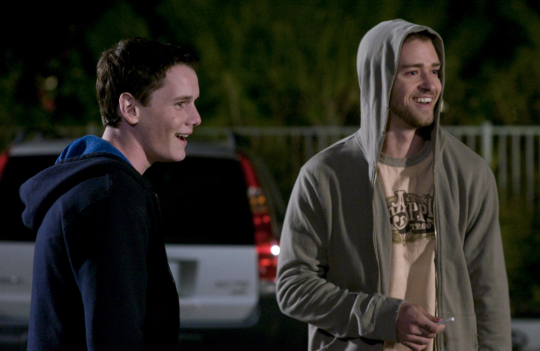
[Last year, Musings paid homage to Produced and Abandoned: The Best Films You’ve Never Seen, a review anthology from the National Society of Film Critics that championed studio orphans from the ‘70s and ‘80s. In the days before the Internet, young cinephiles like myself relied on reference books and anthologies to lead us to films we might not have discovered otherwise. Released in 1990, Produced and Abandoned was a foundational piece of work, introducing me to such wonders as Cutter’s Way, Lost in America, High Tide, Choose Me, Housekeeping, and Fat City. (You can find the full list of entries here.) Our first round of Produced and Abandoned essays included Angelica Jade Bastién on By the Sea, Mike D’Angelo on The Counselor, Judy Berman on Velvet Goldmine, and Keith Phipps on O.C. and Stiggs. Today, Musings concludes our month-long round of essays about tarnished gems, in the hope they’ll get a second look. Or, more likely, a first. —Scott Tobias, editor.]
A decade before the presidency that elevated insults like “betacuck” and “soyboy” into political discourse, Nick Cassavetes made Alpha Dog, a cautionary tragedy about masculinity that audiences ignored. Time for a reappraisal. Alpha Dog is about a real murder. Over a three-day weekend in August of 2000, 15-year-old Zach Mazursky—in reality, named Nicholas Markowitz—is kidnapped and killed by the posse of 20-year-old San Fernando Valley drug dealer Johnny Truelove (Emile Hirsch) with a grudge against Zach’s older brother. No one thought the boy would die, not his main babysitter Frankie (Justin Timberlake), not the girls invited to party with “Stolen Boy,” and not even the boy himself, played with naive perfection by Anton Yelchin, who played video games and pounded beers assuming that his new captor-friends would eventually take him home.
Cassavetes’ daughter went to the same high school as Nicholas Markowitz. The murderers were neighborhood kids and he wanted to understand how fortunate sons with their whole lives ahead of them wound up in prison. The trigger man, Ryan Hoyt—“Elvis” in the film—had never even gotten a speeding ticket. Prosecutor Ron Zonen hoped the publicity around Alpha Dog would help the public spot the real-life Johnny, named Jesse James Hollywood, who was still on the lam despite being one of America’s Most Wanted. So the lawyers gave Cassavetes access to everything: crime scene photos, trial transcripts, psychological profiles, police reports, and their permission to contact the criminals and their parents. Cassavetes even took his actors to meet their counterparts, driving Justin Timberlake to a maximum security prison to get the vibe of the actual Frankie, and introducing Sharon Stone to Nicholas Markowitz’s mother, a broken woman who attempted suicide a dozen times in the years after her son's death.
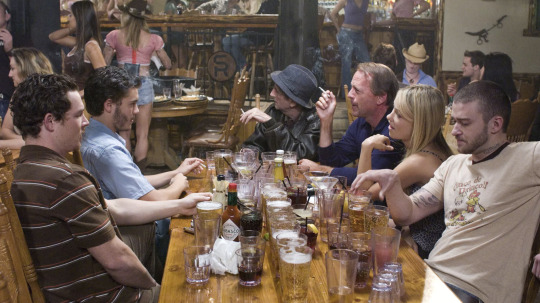
Alpha Dog, pronounced Cassavetes, was “95 percent accurate.” Which was part of why it got buried, thanks to Jesse James Hollywood’s arrest just weeks after the film wrapped. Cassavetes hastily wrote a new ending to the movie, but his problems were just beginning. Hollywood’s lawyers insisted Alpha Dog would prevent their client from getting a fair trial, and used the threat of a mistrial to force Zonen off the case. “I don't know what Zonen was thinking, handing over the files,” gloated Hollywood’s defense team. “It was stupid.”
The publicity, and the delays, dragged out the pain for Markowitz’s family, especially when they heard Cassavetes had paid Hollywood’s father an, er, consulting fee. “Where is the justice in that?” asked the victim's brother. “This just goes on and on, and I’m spending my whole life in a courtroom.”
The film, too, was pushed back a year from its Sundance premiere. Despite casting a visionary young ensemble—Alpha Dog was my own introduction to Yelchin, Ben Foster, Olivia Wilde, Amanda Seyfried, Amber Heard, and the realization that Timberlake, that kid from N*SYNC, could actually act—no one noticed when it slid into theaters in January of 2007. It wasn’t just the bad press. It was that audiences couldn’t get past that Cassavetes’ last film was The Notebook. No way could the guy behind the biggest romantic weepy of a generation make something raw and cool.
But he had. Alpha Dog is a stunning movie about machismo and fate, two tag-team traits that destroy lives. Think Oedipus convincing himself he can outwit the oracle of Delphi. But Sophocles’ Oedipus telegraphs its intentions, elbowing the audience to see the end at the beginning. Greeks sitting down in 405 BC knew they were watching a tale that came full circle. Every step Oedipus takes away from his patricidal destiny just moves him closer to it.

If you map Alpha Dog’s script, instead of a loop, it looks like a horizontal line that plummets off a cliff. For most of its running time, Alpha Dog could pass for a coming-of-age flick where a sheltered kid with an over-protective mom (Sharon Stone) taps into his own self-confidence, right up until the scene where he tumbles into his own grave. Audiences who’d missed the news articles about the case weren’t clued into the climax. Cassavetes doesn’t offer any hints or flash-forwards, not even an ominous “based-on-a-true-story.” (The film might have been more successful if he had.) Instead, he lulls you into joining the kegger, watching Zach crack open beer after beer as though he expects to live forever. “There’s a movie sensibility that the film doesn’t conform to,” said Cassavetes. “You don’t watch this film. You endure it.”
As Zach, his eyes red-rimmed from bong rips, not tears, is shuttled between party dens and wealthy homes, he’s given several chances to escape. He’s even revealed to be a Tae Kwan Do blackbelt who can jokingly flip his captor-buddy Frankie (Justin Timberlake) into a bathtub. But Zach stays put—he doesn’t want to get his big brother Jake (Ben Foster) in more trouble, not realizing that Johnny is too busy making nervous phone calls to his lawyer and his aggro father Sonny (Bruce Willis) to get around to asking Jake for the $1200 in ransom money.
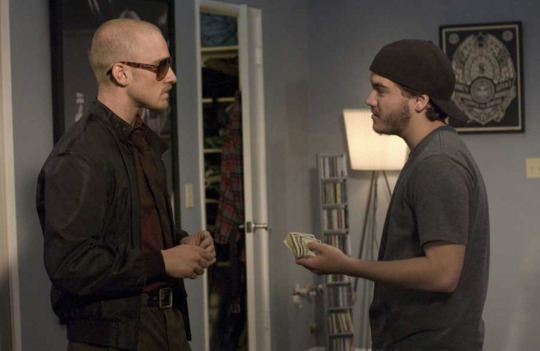
Zach’s death is disorienting, almost as if Psycho's Marion Crane got murdered in the second-to-last reel. In a minivan en route to his execution, he innocently tells Frankie he wants learn to play guitar. “It bugs me that I don’t know how to do anything,” he sighs. Meanwhile Johnny assures his dad that there’s no need to call off the killing. “These guys are such fuck-ups, nothing's gonna happen,” he shrugs, a rare example of cross-cutting that defuses tension in order to make the shock of the gunfire even worse. Up until the last second—even after Frankie binds him with duct tape—a sobbing Zach still can’t believe Frankie would hurt him, and honestly, Frankie can’t believe it himself. And Yelchin’s own early death makes you ache for him to get a happy ending, which Cassavetes dangles just out of reach.
This is how evil happens, says Cassavetes. Masterminds are rare. Instead, people like Frankie can be basically good, but can also be panicky and passive and selfish. Shoving Zach in Johnny’s van was an idiotic impulse by upper middle-class kids, who flipped out when they realized the snatching could get them a lifetime sentence. There’s no honor or glory in the violence. Johnny, the cowardly ringleader, talks tough, but orders his most craven friend, Elvis (Shawn Hatosy), to pull the trigger while he and his girlfriend Angela (Olivia Wilde) get drunk on margaritas. And after the murder, one side effect is that Johnny can’t get an erection. When Angela tries to get Johnny in the mood in their hideout motel, the walls close in on him, suffocating the mood.
Away from his boys, Johnny is weak. Surrounded by them, he's the king. Alpha Dog sets up a culture of animalistic dominance. Johnny’s rental house is basically a primate cage at the zoo, only decorated with weight benches and Scarface posters. All of Johnny’s boys jockey to be his favorite and tear each other down in order to bump up their own rank. Kindness is weakness. When a fellow dealer with the ridiculous nickname Bobby 911 cruises by to negotiate a sale, he snarls at a guy who vouches for him: “You don’t need to tell him I’m good for it, man!”
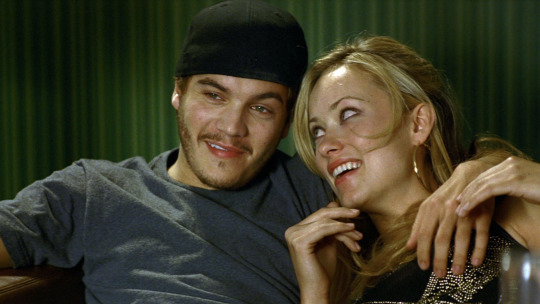
Elvis, the future shooter, is the lowest member of the pack. He can’t ease into the group without Johnny ordering him to go pick up his pit-bull's poop in the backyard. Why do they pick on Elvis? He owes Johnny a bit of money, but the source of the scorn is simply group think. No one wants to be nice to the outcast, and Elvis is just too sincere to be taken seriously. When Elvis offers to get Johnny a beer, the guys tease him for being in love with Johnny. When he says sure, he does care about Johnny, they twist words into a gay panic joke. Elvis can’t win—they won’t let him—so he literally kills to prove his worth, and winds up sentenced to death row, where the real boy, just 21 at the time of the shooting, remains today. Another life wasted.
Cassavetes humanizes the killers because he wants us to understand how their micro decisions add up to murder. Not just the gunmen. Everyone’s a little to blame. The kids who got drunk with “Stolen Boy” and didn’t call the police. The girls who told Zach that being kidnapped made him sexy. Even Zach’s older step-brother Jake, an addict with a twitchy temper who escalates his war with Johnny to a fatal breaking point. Neither boy will back down over a $1200 debt, and there’s an awful split screen call when Johnny dials Jake intending to bring Zach home, but Jake is so boiling over with anger, his Bugs Bunny voice shrieking with outrage, that Johnny just hangs up the phone.
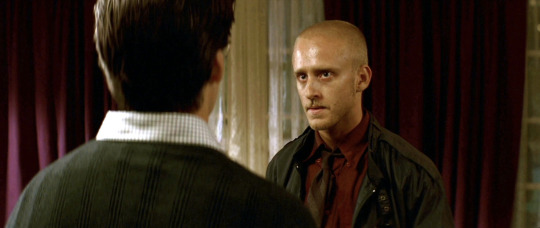
The opening credits, a montage of the cast’s own old home videos, underline that these were young and happy children—the kind of kids people point to as examples of the suburban American ideal. Over a treacly cover of “Somewhere Over the Rainbow,” we watch these real life boys being cultured to be brave: riding bikes, falling off dive-boards, running around with toy guns, going through the rituals of young manhood, from bar mitzvahs to karate lessons. Yelchin—recognizably dark-eyed and solemn even as a toddler—grins wearing plastic vampire teeth.
It takes another ten minutes for Yelchin’s character to sneak into the film sideways in a profile shot eating dinner with his parents, played by Sharon Stone and David Thornton. His Zach is barely even visible as brash Jake barges into the scene to beg for money. They say no, Jake stomps out, and Zach finally makes himself seen when he runs after his brother, begging to go anywhere less suffocating. Zach’s mom loves him so much that she watches him sleep. “I’m not fucking eight!” he yelps. He’s 15—practically a man, in his own imagination—and desperate to get away, even if it means mimicking Jake, a Jewish kid who’s so scrambled that he has a Hebrew tattoo on his clavicle and a swastika inked on his back. Jake starts to say that he wishes his own mom cared about him that much, but as soon as he gets vulnerable, he spins the moment into a joke. “Boo for me,” Jake grins, and takes another swig of beer.
“You could say it’s about drugs or guns or disaffected youth, but this whole thing is about parenting,” grunts Bruce Willis’ Sonny Truelove. “It’s about taking care of your children. You take care of yours, I take care of mine.” He’s half-right—his parenting is half to blame. Sonny and his best friend Cosmo (Harry Dean Stanton) taught Johnny to bully his friends. Cosmo, looking haggard and hollow, mocks Johnny for having one girlfriend. “You gotta plow some fucking fields,” he bellows. “Men are not supposed to be monopolous!” Not that “monopolous” is a real word, and not that Cosmo fends off women himself, except in his own big talk.
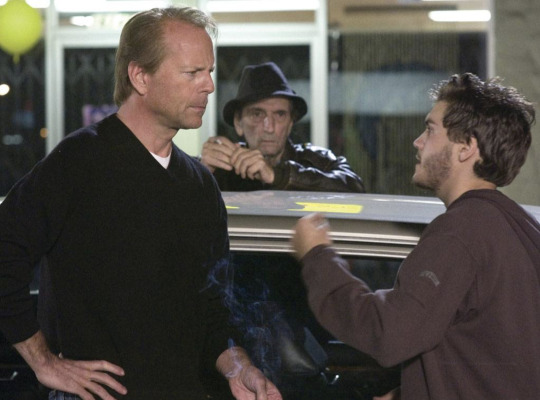
Cosmo and Sonny’s own posturing gradually emerges as being more dangerous than Johnny’s because it's more integrated into society. They’re the type of creeps who rewrite the rulebook to suit them, and attack journalists who try to tell the truth. When a fictitious documentarian asks Sonny about his son's drug connections, the father shrugs, “Did he sell a little weed? Sure.” But when the interviewer presses him further, Sonny snaps, “I’m a taxpayer and I’m a citizen and you are a jerk-off.”
Cassavetes, of course, understands growing up with a father who left a giant footprint to fill. His father, John Cassavetes, the writer-director of Shadows and Faces and A Woman Under the Influence, was one of the major pioneers of independent cinema. He died when Nick was 30, before his son attempted to take up his legacy. “We never really talked film theory,” said Cassavetes. “My experience with my dad was more along the lines of how to be a man, how to be yourself, how to free yourself from what society tells you to do, how to release yourself as an artist.”
It makes sense that Cassavetes would make his own ambitious, and maddeningly singular film. And perhaps it even makes sense to him that fate has yet to give him the reward he’s earned. Alpha Dog deserves to be acknowledged as one of the most incisive examinations of machismo and the banality of evil. But like his fumbling criminals, he knows he’s not really in charge of his life. Admitted Cassavetes, “I'm not smart enough to really have a master plan for my career.”
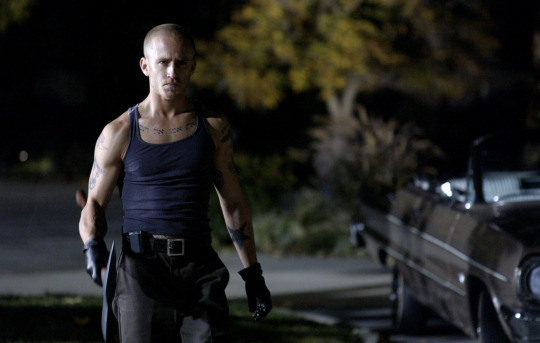
#alpha dog#alpha dog movie#nick cassavetes#john cassavetes#justin timberlake#emile hirsch#ben foster#amanda seyfried#olivia wilde#Nicholas Markowitz#Bruce Willis#Harry Dean Stanton#Oscilloscope Laboratories#O-Scope#musings#film writing
11 notes
·
View notes
Text
Some youkai for your consideration
I’ve often thought it’s a bit of a shame that the legions of Touhou OCs out there seem to limit themselves to shrine maidens, outsiders, the occasional god and ‘actually Remilia has another sister’, when there’s such an enormous wealth of as yet unused legends to pick from. While it’s somewhat off-brand for me, I’ve decided to actually try and change this rather than just sit and complain.
Below the cut, you’ll find a bunch of youkai with a mix of descriptions and suggestions plus, where possible, a link to Wiki or another resource. Anyone who doesn’t care for Touhou might still find some interesting/bizarre folklore (but I repeat myself).
Gashadokuro: Starting strong with a gigantic skeleton. Or, depending on the legend, a swarm and/or gestalt of skeletons. The latter is more accurate, but a popular painting depicted on the wiki page has more or less overwritten the popular perception. The Gashadokuro is said to be invulnerable and invisible, though you can hear it (a ringing sound, surprisingly, and not its footsteps); you can probably also tell it’s around if you’re not completely blind. Being formed from the unburied bodies of those either starved or killed in war, it’s mostly grumpy and hungry, and stalks around biting heads off random people to drink the blood, like a really gory and inefficient vampire. You can probably do some kind of ribcage-coat-and-skull-hat deal if you don’t want to outright go with a skeleton, series aesthetic being what it is. A bamboo eyepatch might be a fun nod to the myth often conflated with it, too (as noted on the Wiki page).
Namahage: Approximately Japanese Krampus with a ridiculously strong northern Japanese accent. They go from house to house brandishing buckets (why? Not a clue) and giant knives or outright machetes, yelling at kids and generally scaring them into behaving. At the request of parents (who give them gifts of mochi), they might throw in a special lesson as well. Then they stomp off to wherever they came from. Originally this was a ‘be good, or...’ kind of myth where the community played into it, but hey, youkai potential. Probably playing the exact same role, which could be funny.
Azukitogi: An old favourite just for being profoundly weird and irrelevant. The Azukitogi is an old man (according to some sources; I’ve always heard the stories casting it as an old woman) who washes their azuki in a river, musing on whether they should keep at it or go eat someone. The latter, to my knowledge, never actually happens, so it’s just a morbid youkai talking to themselves. If you get close, depending on the telling, you will drop into the river. That’s it. It’s just an ugly humanoid youkai sitting around washing beans in the middle of the night, muttering. I feel like it captures the ‘some of them are just kind of there’ spirit of youkai perfectly.
Heikegani: Reaching into animal youkai here, sort of; some do theorise that it’s a kind of haunting. You see, Heikegani have shells that look a bit like scowling samurai masks, and as such, were believed to be the reincarnated souls of Heike clan warriors who died at sea in the sea battle of Dan-no-Ura. Combine that with the whole animal youkai thing and you can easily wrangle up... oh, an extraordinarily (if misleadingly) grumpy-looking, 24/7 armour-wearing crab youkai who has way too many swords. Optionally a ghost. ...What, you don’t think they really look like that? Here you go, then.
Chochin-Obake: Okay, I won’t pretend this is especially innovative. It’s low-hanging fruit, and it’s simple: The archetypical lantern tsukumogami. As such it’s kind of astonishing that I haven’t seen this done more, though?
Todomeki: Literally the ‘demon with hundreds of eyes’, the Todomeki is a towering humanoid woman with countless bird eyes covering her ridiculously long arms. The eyes are, according to several brands of moon logic living in happy coexistence, a symbolic punishment for stealing. No theft occurs in the stories of the Todomeki, and she has a lot of weird powers from somewhere, so this is... weird. Her stories feature her scaring people in a horse graveyard (I did not know this was a thing) for no apparent reason, spouting fire and breathing poison gas, then coming back a long time later to collect the blood and poison gas that she lost so she can recover. I want to further note there was a 400 year delay in between the horse graveyard fight and ‘oh yeah I should go back for my blood and nerve gas’. Possibly for Touhou this gets toned down to a suspicious mess of stolen goods, and eye patterns all over the sleeves of her dress.
Nurikabe: Another in the ‘some Youkai just exist’ brand, the Nurikabe is a living wall of indeterminate origin (depictions make it look kind of dog-like for some reason?) that extends forever. If you knock on it politely, it disappears. Theories on how the myth came about, on the other hand, tend to be either explaining lost travelers... or dietary changes in the lower classes during the Edo period, which led to an outbreak of fatigue and night-blindness. You’d stagger home in the evening, hit a wall you can barely see, and feel like it goes on forever because you’re so tired. Of note, also, is the popular (in Japan, anyhow) Gegege no Kitaro adaptation. Imagine someone buying a figure of this. I don’t understand. To wrap up, the Nurikabe’s motivation is purely to mess with people, as far as anyone can tell. Some theories attribute it to tanuki instead. Oh, and a mountain variety growing out of the mountainside, the Nuribo, also exists.
Ittan-Momen (or here, but there’s not much to be found anywhere): This one provides an interesting counterpoint as an entirely hostile tsukumogami. It’s a roll of cotton that flies on the wind, native to Kagoshima, and either sneaks into houses or bears down on travelers in the middle of the night, wrapping around their face and suffocating them out of sheer spite. It is quite possibly the world’s most hostile blanket, or the ultimate evolution of the sheet ghost.
Inugami (WARNING: Gross and terrible things happen to dogs in the wiki text; do not click if this will upset you greatly): As much a brand of ritual as a creature, the Inugami is the result of one of multiple processes in southern Japan’s distant past that would result in the creation of a vaguely canine spirit. The spirit (described as variations on the theme of a tiny black and white floating thing with a dog’s head) will possess your enemies, bring them to ruin, bring you prosperity, or whatever depending on the telling. It will also haunt your family for generations, so this is kind of a Faustian deal. On the other hand, it has reasons for being angry.
Oboroguruma: A literal monster truck An oxcart, translucent and ghostly, with a giant face on the front. It rattles up to your doorway and makes squeaking noises until you step out and see the cart there, whereupon it appears to do nothing in particular. Youkai. It’s some pretty striking imagery though, which is no surprise since, as the link elaborates, the art came before a story. According to the after-the-fact backstory, it uh, feeds on the petty grumbling of spoiled aristocrats, which seems fairly harmless? Ghost taxi.
Kamaitachi: Another high-profile, if minor youkai. This one has... a thousand origin stories and variations depending on where you go in Japan. I’ll let you hit the link yourself. The core of it is an etymological corruption turned pun. A weasel with sickles for arms, taking the form of a dust devil, whirlwind or just a gale, with the weasel either at the heart of it or invisible outright. The wind cuts people; thus the term Kamaitachi is actually used to this day to refer to any sort of strong wind that feels like it’s cutting/biting into you. I’m going to toss in an excellent drawing by @moominpappa also. Here it is.
Basan: A giant chicken that lives in forests and breathes fire, which as a combination strikes me as a non-survival trait, but what do I know? It... makes bird noises outside but disappears when humans look at it, which strikes me as extremely convenient. I mention it solely because- I mean, click the link. It looks utterly ridiculous. I love it.
Kodama: Alternatively Kotodama, literally ‘tree soul’ or ‘tree spirit’. They’re the spirit of any sacred or spiritually significant tree, a Shinto god of the small-g variety (that is to say, welcome to animism, where everything is a god but not necessarily a high-profile one). You know those little black and white guys from Princess Mononoke? Yeah, those are the ones. They’re basically minor guardian spirits for their tree, and the reason you’ll see trees ringed with braided rope and paper tassels all around Japan. When it’s depicted as anything other than the actual tree, Kodama tend to be pretty small. They’re benevolent unless, of course, you try to cut the tree down, at which point you will pay dearly (but more in the ‘curse your house for seven generations’ sense than ‘whoops, tree ate you’).
Jinmenju (or Ninmenju): The Jinmenju is possibly an extremely displaced Arabic legend about the Waqwaq Tree. It apparently serves no real purpose except to really creep people out, and even that, only by accident. The Jinmenju has fruit shaped like human heads complete with a face (ditto the seeds within), which smiles constantly. If you laugh at it, it will laugh back at you, but laughing too hard will make the fruit fall off. You can eat them, and the tree will not object, nor the fruit. It’s said to be sweet and sour, which carries the horrible implication that someone thought this was a good idea. According to Mizuki Shigeru, there are stories of people who (for some godforsaken reason) planted orchards of these things. They’re mostly found in the south, which probably deserves it for the whole inugami business. Design-wise, you might tone this down by giving the character a green or brown robe with smiling faces drawn all over it (or cut out, Hata no Kokoro-style), and a wooden mask over their actual face (if one exists). Optionally, combine it with the previous youkai so there’s a kodama perched on her shoulder.
That’s about it for now, but I do want to point out that if you want to look further, Yokai.com is a pretty good resource and frequently a more comprehensive one than Wikipedia. Have fun making incredibly weird youkai.
34 notes
·
View notes
Text
Greta Gerwig Is a Director, Not a Muse
By Noreen Malone, October 31, 2017.
source: http://www.vulture.com/2017/10/greta-gerwig-director-lady-bird.html
Dave Matthews Band is generally not considered cool anymore. Almost certainly, it never was in the downtown New York world of which the actress and writer Greta Gerwig has become a cool-girl-real-girl avatar in recent years. But in a time and place (America’s vast, yearning middle-class suburbs, in the cultural desert of the Clinton and early Bush years) and to a certain kind of person (such as a teenager aching for the jazz-adjacent cred that jam-band fandom could provide but more comfortable with white ball caps and lacrosse than ponchos and hallucinogens), Dave Matthews Band was Bob Dylan in Greenwich Village in 1966. And so there is a crucial moment in Lady Bird, Gerwig’s solo directorial debut, in which the title character, a Sacramento high-school senior in 2003, confronts the cruelest heartbreak imaginable to her by blasting the band’s ballad “Crash Into Me”: “Sweet like candy to my soul / Sweet you rock and sweet you roll.” The result is both sympathetic, and very funny.
“There was no other song it ever was going to be,” Gerwig said. “In preproduction, I realized I didn’t know what I was going to do if Dave said no [to its use]. I wrote him a letter. ‘Dear Mr. Dave Matthews … ’ ”
Gerwig was sitting at a small corner table near the window at Morandi in the West Village, not far from where she lives with the filmmaker Noah Baumbach. “I thought it was a really romantic song when I was a teenager. I would listen to it on repeat on a yellow CD player,” she said. “I couldn’t imagine a world in which a guy would feel that way about me.”
Maybe it was because of her sexy dirndl skirt of a name, maybe because of her squinting physical resemblance to indie Gen-X avatar Chloë Sevigny, maybe simply because of her distinctive delivery. But since the very beginning of Gerwig’s career, she has been a generational lightning rod of sorts. As what the New York Observer once called “the Meryl Streep of mumblecore” — the hyperlow-budget late-aughts movie movement led by directors like Joe Swanberg and the Duplass brothers — Gerwig was near-instantly labeled an “It” girl and invested with all sorts of theories about what her success and acting style meant. Her brand of hipness was confusing — was she really that earnest? Were they all that earnest? How could that possibly be cool? Critics, especially those of an older generation, were suspicious.
She was, unmistakably, a gifted actress. But the Guardian also called her “the poster girl for wayward, brittle middle-youth,” a “galumphing work in progress.” In The New Yorker, Ian Parker wrote that, despite having a “precise, literate mind,” Gerwig “has the air, not uncommon among her contemporaries, of having swallowed a very low dose of LSD.” “Ms. Gerwig, most likely without intending to be anything of the kind, may well be the definitive screen actress of her generation, a judgment I offer with all sincerity and a measure of ambivalence,” A. O. Scott wrote in the New York Times. “Part of her accomplishment is that most of the time she doesn’t seem to be acting at all. The transparency of her performances has less to do with exquisitely refined technique than with the apparent absence of any method.” And then there was this sort of thing: “While watching Greta Gerwig on screen, you might be tempted to kiss her,” wrote Stephen Heyman in T in 2010. “This is not meant purely as praise. Gerwig, 26, plays characters who are given to discursive verbal forays with oodles of ‘ummmms.’ So planting an unexpected kiss would not only be a recognition of her adorableness but also a useful way to shut her up.”
In a way, then, Lady Bird, a remarkably self-assured debut, feels like a rebuke. Or at least an assertion of artistic intent. At 34, and moving, finally, behind the camera, Gerwig is exiting the phase of her life where she’ll be asked to represent a mysterious, fascinating rising generation. The winds have shifted some, and the microgeneration after her is just as earnest (or more so) but culturally preoccupied less with its own emotional wanderings than with larger political questions of identity, and of race. Gerwig seems still to be considering, and even reclaiming, some of the traits that hers has been tagged with: nostalgia, that earnestness, parental attachment. In other words, what does it look like onscreen when millennial sincerity is treated not with mockery or puzzlement but with, well, sincerity?
Gerwig appears to be a genuinely sincere person, a kind of spiritually permanent college student, in a way that might get under the skin of someone with more ironic armor. She wears a giant Hello, Dolly! sweatshirt and an even more giant backpack. She references Tina Fey’s Bossypants like scripture and listens to podcasts about entrepreneurship (“The one about the woman who created Spanx made me sob”) and religion (“Krista Tippett” — the host of On Being — “is like my fucking queen”). She quotes Rabbi Abraham Joshua Heschel to express her sadness over the Harvey Weinstein mess: “In a free society, some are guilty; all are responsible.” She goes to church sometimes, and though she doesn’t subscribe to any particular denomination (“The Catholic theatrics are pretty high quality, but the Protestants have better hymns”), she’s really into the Quakers right now: “There’s nothing that you have to believe or avow. The only thing you have to believe is that the light of God exists within each person.” She really, really loved her single-sex education, both the high-school portion and at Barnard, where she was delighted to discover that all the doctors at the health center were gynecologists and enjoyed her time on the parliamentary debate team.
Gerwig’s enthusiasms extend also to Zumba, but what she really likes is a barre class run by this one woman from Portland, Oregon, whom she admires for her “body positivity,” and on the day we first met, she was, with some embarrassment, about to try something called the Class, in which Tribeca women combine burpees and cathartic screaming. “It seems like maybe the fitness equivalent of the toy poodle,” she said. “Like, you have to admit that you love them and you want one that’s tiny. You’d rather be the girl who has a German shepherd who goes for a run. Not one with a fluffy piece of lint who goes to a place where you chant with crystals.” She considered. “Before they poured the floor at the studio, I read, they put rose quartz everywhere, and I was like, I mean … I can get down with that.” She has a friend who works for Moon Juice, and so she speaks highly of its sprouted almonds, even if “I always thought it was kind of ironic when she’d be stressing out about the moon powders.”
The author and illustrator Leanne Shapton, who knows Gerwig and Baumbach from the neighborhood, spotted Gerwig and stopped to chitchat. Shapton, as it turned out, designed the font for Lady Bird’s title and credits: “She made an entire uppercase and lowercase alphabet and painted it ten times the size that it needed to be and shrunk it down so it looks like a font but has enough imperfections so there’s a density,” Gerwig told me after Shapton had walked away. “I feel like movies are presents, and credits and fonts are bows and wrapping paper.” She paused. “I like everything to feel like it was given a lot of time. I hate it when I watch movies and it seems like they just went and picked a font and, like, called it a day.” She paused again, considering Shapton. “I also have a crush on her because she’s very beautiful. She is cool in the way that everyone wants to be, but she’s also a real person.”
“I’ve made so many films in New York,” Gerwig said, that “there was an assumption I think a lot of people had that I am a New Yorker, that I am from New York, and I always felt like nothing could be further from the truth. I’ve done a good job of convincing you, but I’m not, as so many people who live in New York are not.”
Lady Bird, which is also Gerwig’s solo writing debut, is the story of a high-school senior (Saoirse Ronan) at an all-girls Catholic school in Sacramento who longs — despite her average grades — to be the star of the school play, to go to college on the East Coast, to be extraordinary. Though her name is Christine, she insists on being called “Lady Bird,” a pretension with which her salt-of-the-earth parents — a nurse and an out-of-work computer programmer, played with extraordinary sensitivity by Laurie Metcalf and Tracy Letts — comply. (It’s a complicated dynamic: Metcalf calls the mother character “totally passive-aggressive.”) The plot is a gentle one. Lady Bird acquires a couple of boyfriends (each recognizable as a classic type who might appeal to a smart-in-some-ways, really-not-in-others teenage girl), chases acceptance from the popular crowd, applies to colleges her family can’t afford to send her to.
Gerwig attended an all-girls Catholic school in Sacramento, with parents who worked as a nurse and a loan officer at a credit union, who sent her off to an expensive East Coast college, and although the movie has been widely discussed as a roman à clef, she says it’s not. For starters, Lady Bird is set in 2003, Gerwig pointed out, and she graduated in 2002. “I never made anyone call me another name. I never had dyed-red hair. She’s so much more wild and outspoken, and I think I was only ever that way in my head. In a way, I felt like I kind of put into her the sheer confidence and the id I find in 8- or 9-year-old girls. They’re just brash, and they don’t know that they should feel anything but great about themselves.
“When you write something you know, you’re making a story that will work, whether or not there’s bits taken. It’s always funny to me when people say, ‘Well, it’s clearly autobiographical,’ and I say, ‘Well, how do you know my autobiography?’ ” she continued. “Certainly, there are things that are connected, but I just think it’s a very interesting assumption. In some ways, it feels akin to the assumption that I’ve experienced as an actor when people say … ‘This is you.’ Which I’ve always taken as a compliment because it felt like you were watching a person.”
The teenage Gerwig was an extensive diarist, but she didn’t look up her old journals until after she’d finished the script, called “Mothers and Daughters” in a first draft that clocked in at 350 pages. (“It originally had a lot more dances,” she said.) When she opened the old pages, she was pleasantly surprised to find that she’d accurately remembered some of the tiny details — the rumor that clove cigarettes had fiberglass in them, the very fact of clove cigarettes at all — that make the movie so spot-on evocative of high school. But mostly it was the vividness of her feelings that struck Gerwig. “I would go on for pages and pages about this crush I had, dissecting every moment. ‘Did he notice that our arms were touching, or was that an accident?’ And then I wrote, ‘Upon further reflection, I think that this might’ve been a more vivid emotional experience for me than him.’ I was like, Oh, honey, nothing you’ve written is more true.”
When Gerwig was young, her parents made a point of taking her to local Sacramento theater — she proudly ticks off the names of the companies, and the playwrights whose work they put on, and even the directors. At Barnard, where she studied playwriting, she became a Kim’s Video devotee, methodically working her way through the director-organized shelves. (It was Claire Denis’s film Beau Travail, she said, that made her shift her focus from theater to movies.) She rejected traditional paths like law and medicine. “Chekhov was a country doctor, spent all his time with people and in their homes. I was like, Well, that’s good, and then I was like, Well, I’m not interested in it, and also I don’t like blood, and there are no country doctors anymore,” she said. “The idea that I would become a doctor to become more like Chekhov is a pretty circular route.”
After college, Gerwig lived all over Brooklyn — East Williamsburg, Prospect Heights, deep Park Slope, or “Park Slide,” as she says fondly. She had odd jobs, including at the Box, the Lower East Side cabaret, and began working with Swanberg, whom she had met through a college boyfriend and who was making interesting movies that were unlike anything that had been done before, for almost no money.
Mumblecore was a big deal, for a small movement, in part for what it seemed to reveal about a certain slice of young, college-educated, mostly white people trying to figure out how they related to the world. It was hailed in the Times as something that “bespeaks a true 21st-century sensibility, reflective of MySpace-like social networks and the voyeurism and intimacy of YouTube. It also signals a paradigm shift in how movies are made and how they find an audience.”
Gerwig now physically cringes at the mere mention of the word mumblecore. “I just hate it,” she said. “It feels like a slight every time I hear it. Because of the improvisational quality of those movies, and the fact that everyone was nonprofessional, I have had a bit of an uphill battle just to say ‘I know how to act.’ I didn’t stumble into this. I wasn’t just a kid.” But she credits her roles in those films — Nights and Weekends, Hannah Takes the Stairs, Baghead — with helping teach her to write. “We called them ‘devised films,’ because we’d know the characters and what was supposed to happen in the scenes but not the words. It was a way of writing while I was acting.”
It was also that set of films — which made a bigger splash in the indie-movie scene than in the culture at large — that put her on Baumbach’s radar. (He actually recommended her to his agent before the two had ever met.) When Baumbach cast her in 2010’s Greenberg, released when she was 26, it was her big break. Shortly after he divorced his wife, the actress Jennifer Jason Leigh (Gerwig had trained for the role, in part, by working as an assistant to Leigh’s mother), the two began their romance. Baumbach and Gerwig turned an email correspondence into a project: The duo co-wrote Frances Ha and Mistress America, both starring Gerwig and both markedly sweeter than anything Baumbach had worked on in the past. “I liked what she was writing so much that it made me work harder with my own to impress her,” Baumbach said.
This collaboration led to a spate of headlines referring to Gerwig not as a partner on the works but as their muse. “The actress Greta Gerwig has had the same liberating effect on Noah Baumbach as Diane Keaton had on Woody Allen: she has opened him up, lending his films a giddy sense of release,” went one typical summation in the Economist.
“I did not love being called a muse,” said Gerwig bluntly. “I didn’t want to be strident about it or say, ‘Hey, give me my due,’ but I did feel like I wasn’t a bystander. It was half-mine, and so that part was difficult. Also I knew secretly that I was engaged with this longer project, and wanted to be a writer and director in my own right, so I felt like the muse business, or whatever it was, was a position that I didn’t identify with in my heart. But I think one thing I learned early because of the group of movies that are called mumblecore” — she slowed down, a little archly, over the word, to acknowledge again her discomfort with it — “is not to attach too much to the moment you’re living through from a press perspective. I also had this sense of, Well, they’ll just eat their hat one day.”
TV was one idea when Gerwig hit a dry spell with acting gigs after making Frances Ha and Mistress America. “I felt like I had done things that I was incredibly proud of and I felt like I had authorship over, and done good work as an actor, but my wheels weren’t catching purchase with whatever the Zeitgeist was,” she said, forking her pasta. It was a curious double identity as an actress — plausibly the face of a generation, particularly of the privileged of that generation, and, just as plausibly, a near-anonymous actress who hadn’t yet made anything that any real number of people had actually seen. She met with the producers behind How I Met Your Dad, a planned spinoff of the long-running, quietly beloved CBS sitcom How I Met Your Mother, and signed up for the starring role, along with a writing role. “It felt like this incredible lifeline for me. It felt like a place to give myself some structure,” she said of what looked from the outside like a bit of a career swerve. Not to mention that she was told it was a “sure thing.” The pilot wasn’t picked up. “They send the shows to Vegas, and people sit there with knobs, and they turn the knob down if they don’t like an actor,” Gerwig explained with a little embarrassment. “Nobody exactly told me I tested low, but it was insinuated that America did not like it.”
But that allowed her to turn to directing. “By the time I started, I felt like I had ten years of training. My film school was as an actor and co-writer and co-director, and whatever else I did, which included costuming, and holding the boom, and editing. It was a way for me to get my Malcolm Gladwell hours in.” She also benefited from more targeted instruction, in recent years, from DPs who’d heard she wanted to direct and let her sit with them while they constructed their shots. “When I finished the script, I had a moment with myself where I thought, You’re either going to do this now or you’re never going to do this,” she said. “Now you have to make your mistakes and get your gifts because you have to, at some point, jump. I think a lot of women have also particularly a need to feel that they can stand in their own expertise before doing something. A lot of my female friends will be so overqualified for what they do that by the time they do it, it’s like, Well, obviously.”
During the press tour for Mistress America, a journalist asked about whether dating Baumbach, and then writing with him, had opened certain doors for her. Gerwig acknowledged that perhaps it had, proximally, but refused to concede the larger point. “I don’t mean to sound annoying,” she told the reporter, “but I would have done it anyway. I will find that one door and then push it wide open. I’m lucky to find collaborators and kindred spirits. But I don’t need a man, and I would have done it anyway.”
A confident, direct version of ambition is another generational trait that Gerwig seems to comfortably inhabit. Recently, she saw Saoirse Ronan in London to promote the film; Ronan told her she was beginning to think about whether she could direct, inspired in part by watching her on set. “Greta is the one that I’d want to emulate,” Ronan told me. “She was incredibly clear about what she wanted but also supportive about finding our own way through the characters. We’ve been talking in a practical way, too, about stories that I’d like to do and if I could work with her in that regard. She’s a great one for the advice.”
Ronan was also struck by Gerwig’s actorly approach to directing. “She had very clearly mapped out each character’s journey, what it would be like to be a kid in post-9/11 America in California, how complicated it would be to think about leaving Sacramento for the first time,” but also “she gave us an awful lot of freedom to incorporate our own selves.” Gerwig even gave Timothée Chalamet, who plays one of Lady Bird’s love interests — a self-styled high-school intellectual — a syllabus for “what a paranoid anarchist type of thinker would have been reading back then,” he said, which included, in addition to the requisite Howard Zinn that shows up in the movie, The Internet Does Not Exist, an essay collection that warns of the dangers of a networked world. She also asked him to watch Eric Rohmer’s My Night at Maud’s, which she told me contains a character who is an example of a long-standing type: “These guys who are just completely stuck on their ideas, whether music or progressive philosophy or whatever it is. Like, ‘I’m going to train you to like Pavement.’ ” Gerwig also gave specific directions on how to play the many comic moments in the script: Humor was to be achieved not through comic acting but by playing the situation with all the seriousness with which a high schooler would feel it. “I like things that are funny,” Gerwig said, “but I don’t like things that are in quotes.”
Gerwig plans to tip the balance of her work going forward more toward writing and directing (though she’d like to keep acting). “You just stay in it long enough, and eventually you’ll just be old.” Nobody will worry over whether you are an actor or a director or a writer. “Everyone will just think, Oh, she’s such a wonderful 75-year-old now. She’s our lady Clint Eastwood.”
She has one script, something she wrote before Lady Bird, in the drawer, but for her next project, “I have an inkling of wanting to make something that’s more silent, literally fewer words.” She wouldn’t give any more detail, however. “I worry if I put an idea out in the sunlight too early, it shrivels, and I don’t want to shrivel anything right now.”
Baumbach’s most recent film, The Meyerowitz Stories, was released on Netflix and in theaters just a few weeks before Lady Bird, which comes out on November 3. Both movies open with a parent and child, driving together, on the cusp of the difficult moment when college is about to force that relationship into its next, more distant, phase; both puncture the sweetness of the scene by someone melting down immaturely. In Baumbach’s film, it’s the parent. In Gerwig’s, it’s the daughter.
With Mistress America and Frances Ha, said Baumbach, the pair were able to create “a synthesis” of their two voices, “a kind of a third thing that allows you to try different selves on.” But the couple have strikingly different tones to their independent work, although they tread the same thematic ground (and give each other notes on drafts). Family, in much of Baumbach’s filmography, has been a source of neuroticism for his protagonists, often children picking up the pieces, learning to overcome the limits of a selfish, immature parent’s love. Lady Bird, by contrast, is about a child failing to recognize, in the moment, the expansiveness and totality of her parent’s love for her — as well as the complicated dynamic between teen girls and their mothers, even those who are fond of each other. Baumbach, though, sees their emotional truths as more related. Both movies, he said, are about “how hard it is to acknowledge positive things in someone you need to move away from, and how hard it is to leave.” Gerwig’s story is, in her phrasing, “a movie about wanting to leave a place that’s secretly a love letter to the place, and a movie ostensibly about a daughter that’s secretly about the mother.”
“Oh, I’ve got a lot of guilt,” Gerwig replied quickly when I mentioned that I had seen the film as, in part, a meditation on that particular emotion, and how deeply it can become intertwined with love. “We always joked that we should put up a title card at the end of the movie that said CALL YOUR MOTHER,” she said. The guilt kicked in. “I need to call my mother.”
Gerwig showed her parents and friends the script before shooting and screened the film for them before it premiered, but she also spent a lot of time considering how she’d treated her mother as a teenager. “I could only see the faults in clear relief, but as I’ve gotten older, it’s like, Goddamn, she was right about almost everything.”
For all that she insists Lady Bird isn’t exactly her own story, it feels like a coming-out of sorts for Gerwig’s own sensibility, her preoccupations. “I only ever write from a place of love,” said Gerwig, “which sounds goofy but is actually true. Some writers write from a place of anger or analysis, or something that feels more didactic, but that impulse means that I also write out of real love, which is complicated and changing.”
“Sincerity means a lot to me,” Gerwig continued. “Actually, in Frances Ha, at the beginning, she’s reading out of a literary-criticism book called Sincerity and Authenticity. Basically, the question she’s setting up is, what do we mean by sincerity, and does it diminish the thing?” She considered. “But I’ve always felt like it heightens it.”
1 note
·
View note
Text
Sugilite: What was Sapphire’s deal?
For a long time since the reveal of Ruby and Sapphire, I’ve been seeing posts that (jokingly or not) suggest that Sugilite’s behavior, as a Fusion of Ruby, Sapphire, and Amethyst, was the result of the rambunctious Ruby and Amethyst dragging Sapphire along for the ride.
I kinda get why people say that, because obviously both Amethyst and Ruby are prone to anger and sometimes lack filters and coping mechanisms. Meanwhile, Sapphire seems so calm and in control. Surely Sugilite was mostly Amethyst and Ruby getting carried away.
But y’all have seen “Keystone Motel.”

“This will pass. She’ll eventually just burn herself out.”
Sapphire, when she’s upset, pretends to be above it all, ignores others’ emotions while denying the effects of her own, and even resorts to shaming those she loves when she’s not happy with their behavior.
She can be callous. Cold.
Sapphire is just as responsible for everything that went on with Sugilite as Ruby and Amethyst were.
Now here’s the thing. Fusions can feel like they’re one being--especially when they get used to being fused--and though they’re “a conversation” and “a relationship,” they’re also capable of functioning like a single consciousness despite that they technically can never quite be “individuals.” So I do hesitate to pick apart “what comes from which Gem” when examining Fusions’ behavior. However, much like you can analyze the traits of a child and surmise which parent they “get it from,” you can sort of do that with Fusions. But there’s another element you have to keep in mind when you do this.

A manifestation of the fusers’ influence on each other.
Guide to the Crystal Gems is the source of this tidbit--a canon source authored by Rebecca Sugar. You don’t really see the “influence” aspect discussed explicitly in the show, but this implies that Fusions aren’t just what their components are, but what they inspire in each other. What they think of each other, what they expect from each other, what they want to be together. What they bring out in each other, regardless of whether that element is usually part of the individuals.
Look at Smoky Quartz. Before they appeared, Steven and Amethyst had just had an arc with a competitive and self-deprecating tone which led directly to forming Smoky for the first time. They literally fought each other over who was the worst, had a discussion of not living up to what they were supposed to be, and aired their grievances over the proper path to improvement.
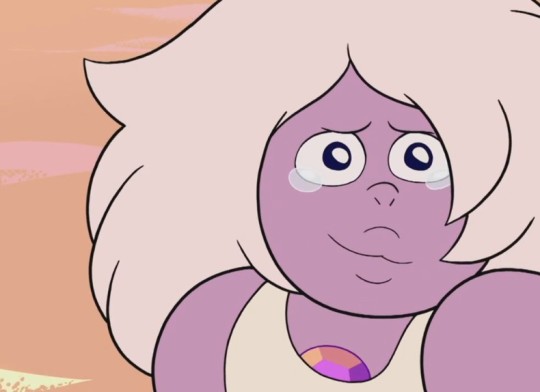
“Us worst Gems stick together, right?” “That’s why we’re the best.”
Amethyst and Steven literally formed their collective identity based on their low self-esteem and feelings of inadequacy. They play it like a big joke, of course, cracking puns and offering distractions, but when Sardonyx presses them during their second appearance in “Know Your Fusion,” Smoky heaps on the self-abuse.
“I guess zero plus zero equals zero. They say two wrongs don’t make a right--I guess I’m living proof that that’s true! I’m just one big super-wrong good-for-nothing dud with a yo-yo!”
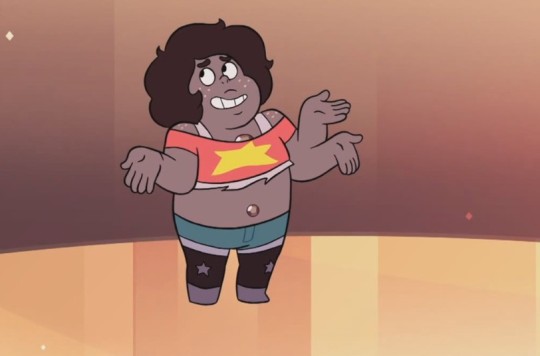
Delivered with a smile.
Supposedly it’s a common trait of youngest children to be the comedian of the family--if you’ve spent your whole life feeling like those who came before you have won all the awards, done it all before you, and met stratospheric goals before you even found your feet, you might feel like there’s no point in performing well, so you joke about it and poke fun at everything, including yourself. Amethyst and Steven have both spent a lot of their lives feeling like the youngest child who’s a bit of a screw-up with whom everyone must be patient. Smoky doubles that feeling, and when they start to feel inadequate, out come the self-deprecating jokes.
Sugilite is more complicated because she’s a three-Gem Fusion, but I’d like to first refer to my “How Fusion Relationships Work” post and assert that Sugilite is far more a relationship of Amethyst and Garnet than she is a relationship of Amethyst, Ruby, and Sapphire. If Sugilite were to internally argue with herself the way Alexandrite did in “Fusion Cuisine,” you’d probably hear Amethyst’s and Garnet’s voices, not Ruby’s or Sapphire’s. I could be wrong, but I think Sugilite is better understood as Garnet and Amethyst’s Fusion. Therefore, to find out what comes from Sapphire and what comes from Ruby in Sugilite, it makes more sense to pick apart where their traits feed into Garnet first.
Sardonyx and Sugilite are both Garnet Fusions. And Sardonyx and Sugilite have both shown an incredible capacity for showing off for Steven. We know Pearl loves to perform, but Sardonyx seeks to impress through grace and precision, while Sugilite is about power. That is likely a strong Amethyst trait--she REALLY wants to be strong, and she thinks Garnet is this incredible pillar of strength. Amethyst’s beliefs about Garnet and desire to be strong would feed into making Sugilite the powerhouse she is.
And Amethyst also has abandonment issues.

“What about ME, huh? I had someone who was always there for ME until she started hanging out with YOU!”
What was Sugilite’s apparent main complaint?
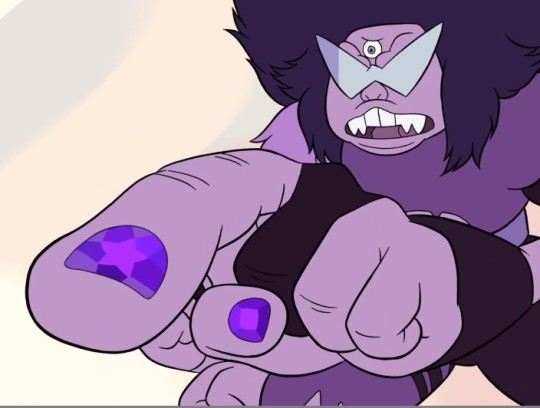
“You left me behind!”
She was left alone with no one to perform for, no one to encourage her or make her feel cool for being strong enough to take out all those pillars.
This seems like an awful lot of Amethyst, but what about Garnet?
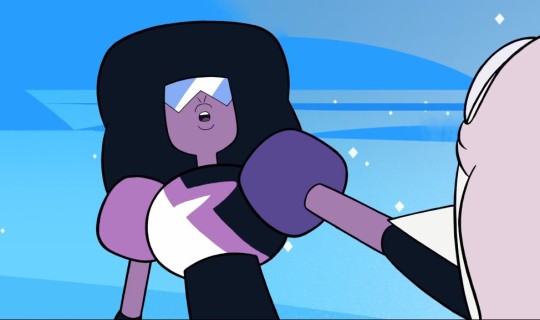
“We don’t need to be careful. We just need to be huge.”
Get the job done, Garnet. Who cares about Pearl’s feelings? Who cares if there might be some speed bumps? It’ll turn out with the result we need, and that’s all that really matters.
Well, that’s some Sapphire there.
That’s probably exacerbated further when all the frustration and feeling of being left out was amplified by Amethyst’s perspective, and it’s all directed at Pearl. What might Sugilite be thinking about Pearl? “She’s to blame! She took Steven away and abandoned me! She called me ‘too much’ because she’s just too little! And now she wants me to unfuse just when I’m enjoying myself! She’s probably just jealous Garnet didn’t pick her instead!”
There’s a ton of feeling in there and not a whole lot of thinking. And feeling is something Ruby does extremely well. Meaning she does a lot of it, and she doesn’t think about the past or the future. Now is all she can think about, and her incredibly important, long history with Pearl and any future consequences are beside the point in the face of all that emotion. Sugilite feels hurt and angry and vengeful now. And she has a ton of power that this little Gem Pearl wants to take from her. She won’t let it happen.
But here’s something complicated. Ruby is emotional, but she isn’t selfish. She’s almost entirely selfless. I mean that literally, too--at the beginning of her life with Sapphire, she expressed that it didn’t matter if she was broken because there are tons of her. Even more recently in her life, in “Jailbreak,” she cared about what happened to Sapphire but had no thoughts for herself.
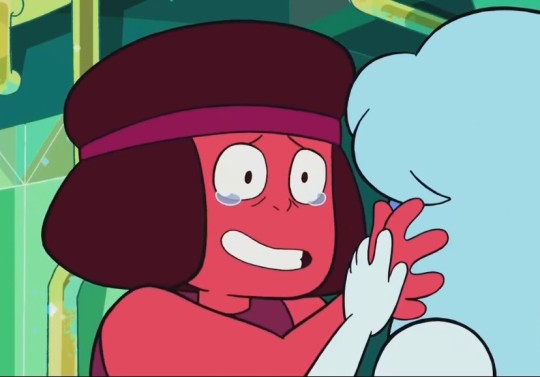
“Did they hurt you?” “WHO CARES??”
And if you listen to her rant about Blue Diamond in “Gem Heist,” Ruby still offers an onslaught of anger that has almost nothing to do with slights against her.
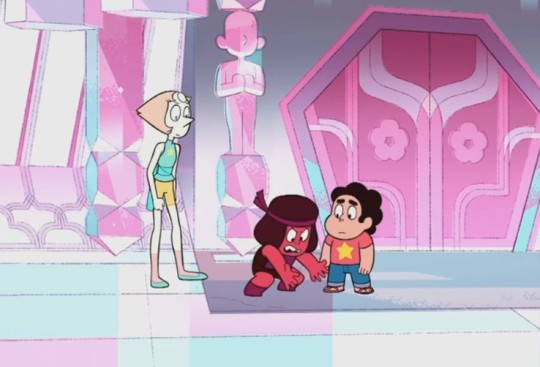
“She’s a shatterer! She yelled at Sapphire, she hates fusion and love!”
Hear that? Blue Diamond had specifically threatened to shatter Ruby, but she doesn’t say “she threatened to shatter me.” She just uses general terms about her being “a shatterer” before launching right into how Blue Diamond mistreated Sapphire and hates their union. And, going back to “Keystone Motel,” it’s more of the same from Ruby: she’s angry not because Pearl personally hurt her, but because Pearl disrespected fusion. Disrespected Garnet.
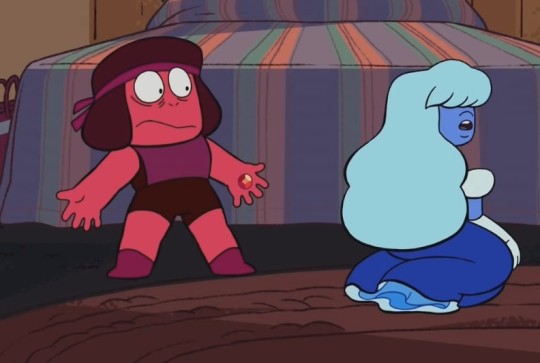
“It’s FUSION, Sapphire! What’s more personal to us than fusion?”
She’s so, so angry, but it’s on behalf of their relationship, not on her own behalf. She’s not mad at Sapphire for wronging her. She’s mad at Sapphire because this is about fusion. Without fusion, Ruby doesn’t even think of herself as worth something to be mad about. But the fusion she’s contributing to? Wow, nobody better EVER say anything against THAT, or insult it for ANY reason!
So, no doubt this is magnified in Sugilite.
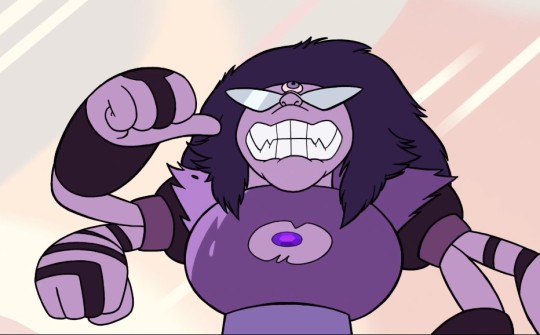
“I AM myself, and I’m SICK of being split up!”
Amethyst’s respect for power, Ruby’s respect for fusion partnerships, and Sapphire’s respect for outcome over process all contribute to Sugilite’s motives. But Amethyst’s sullenness over abandonment, Ruby’s single-minded emotion, and Sapphire’s callousness make those motives manifest in a destructive way.
When Garnet is just Garnet, she has effective coping mechanisms most of the time, at least when it comes to losing control. But Ruby’s EXPLOSIVE emotion is very present in Garnet--we repeatedly see her punch first and ask questions later, or break things just because she’s pissed off. Sapphire’s soft-spokenness and withdrawal from full engagement are also very present in Garnet, and we see her withholding emotion or letting her overconfidence make her stubborn. But she’s balanced, and she carries leadership without cracking, and she rarely makes her problems into other people’s problems.
But when Garnet is part of Sugilite, emotion is streaming in from Amethyst AND Ruby, and neither of those Gems likes to think outside the present. If you said Sapphire’s future vision and composure is “drowned out” by such passionate energy, you wouldn’t be far off, but I think it’s more nuanced than that: Sapphire’s traits manifest differently. Amethyst respects the heck out of Garnet, and Ruby feels like Sapphire matters far more than she does. Sapphire holds a good deal of the self-respect in Sugilite--the part of her that thinks she deserves attention, dignity, and honor. There’s still some aristocrat in her. In Sugilite, that respect is up against an overwhelming amount of self-directed belittling and inadequacy. So you get someone who knows she should be respected but feels that she doesn’t deserve it.
Ruby and Amethyst may be the source of Sugilite’s fury and pain, but without Sapphire’s cold indifference, she wouldn’t have ever posed such a threat. Some of the most brutal aspects of Sugilite may have their roots in Sapphire.
1K notes
·
View notes
Text
This may or may not be an unpopular opinion but I still think season 1 of teen titans was the most solidly built, plot-wise and pacing-wise.
I’m not saying its necessarily the best because there’s a lot more to whether a show is “good” than objective quality and the basic “rules”/tropes of fiction, but just speaking from the objective standpoint, my knowledge of how stories are constructed, my own hyperanalytical brain being brought out of enjoying the other seasons because the climaxes felt,,,lacking, its the best season. I also have a slight bias for Robin and his character development but aNYWAYS heres why:
Season 1 of Teen Titans was the only season of Teen Titans that relied on abilities that were shown previously in the show to finish the “final battle” of the season. Season 2 gets a little bit of slack because Terra’s powers’ very nature was unpredictable, and Season 5 TECHNICALLY relied on pre-existing abilities (unless you count all the superheroes they brought out randomly in the finale, but they did at least set it up before the actual battle started) but its just got too many other problems (that were more the fault of the tropes in general than the execution, like they tried with what they were given but its just..not a smart direction to take a story, but anyways) for me to count it. Season 3 and 4 do not have that at all.
The first season’s finale, of course, involves Robin being manipulated by Slade into working for him lest his friends die. The finale is concluded by Robin realizing the source of whats infected his friends and infecting himself with it so that Slade cant kill them without killing him. I’m also just now realizing that Robin literally threatened suicide to protect his friends and I’m having an existential crisis, but the rant must go on. And you can argue that Slade should’ve just killed him too, but Slade was willing to do just about anything to get Robin to be his apprentice, as shown by him putting up with Robin’s rebellious behavior in general and even praising it sometimes, so idk man Slade might be an idiot but it checks out with his prior behavior.
But my point of mentioning this, is that it required thinking. It required Robin to be smart, observant, and quick-thinking - all traits that were expressed quite frequently in that season and were the reason Slade was interested in him in the first place. Slade lets his guard down, and that allows Robin to overpower him.
Season 3 and 4, meanwhile, do have prior hints to their abilities/finales in earlier seasons (namely season 1, or maybe cyborg’s was in season 2 idk i dont remember) but they werent built up like Robin’s. Robin is able to defeat Slade with his own abilities, which were established frequently in season 1. Cyborg does an anime reference and beats the crap out of Brother Blood, and anime reference or not, it was still batshit outta nowhere and he even says “uhhhh i dont think ill ever be able to do that again sorry”. References dont work if they dont fit your story or arent just jokes, like this is a season finale not a cutaway gag.
Season 4, meanwhile, has two episodes referencing the very abilities Raven gains to defeat Trigon, but there’s no buildup to her gaining those abilities. And sure, she’s a bit fricked over by Trigon kinda. killing her a little bit, but if anything that should make her powers weaker, not stronger. And I could’ve argued “well whatever, at least she has new powers” if her powers hadn’t also vanished into thin air like Cyborg’s.
At least Terra’s powers had a reason for disappearing into the night; no other character wasn’t completely in control of their characters, nor did they experience anything that should’ve taken away their powers at the end.
I know its an action show and having your characters become too overpowered either means making bigger and badder villains and ending up with a Dragon Ball situation, but that’s the magic of the first season; Robin doesn’t have to gain anything to defeat his opponent but knowledge about how they work, so much so that Slade was literally able to be the villain again in the next season. And thats the brilliance of Slade or equally unpowered villains like himself; they rely on intimidation and circumstances, but if they let their guard down, they’re easy to defeat.
Like, Slade isn’t a very interesting character because he has no back story and a very weak motivation (that could be strong if he had a backstory, but I digress), and for personal reasons I want to kill him more than any other villain in any other show, but he is a goddamn brilliant plot device. He’d probably be one of the best villains out there if he had any kind of development outside of “I kill because im good at it” (which IS an interesting motivation if you give a reason for it, like I can think of a ton of interesting reasons for him to do that, but ya gotta follow up on it you fools)
There’s a reason why Slade was the primary antagonist in the two seasons that I think had the best built finales.
Robin also has one of the more interesting character arcs in my opinion. I like “you and I are alike, you know” relationships between villains and protagonists, so its a biased pick, but just...idk there’s a reason Robin is still my favorite main teen titan despite not doing all that much in the later seasons except sit around, act edgy, make bad puns, and in general just be an emo nerd.
Idk man. I also find the first season finale absolutely FASCINATING and ive watched it like 4-5 times help
2 notes
·
View notes
Text
What have I ‘got’?
Brain damage, or ‘Acquired Brain Injuries’, depending who I’m speaking to, my ability so say, and spell ‘subarachnoid haemorrhage’ appears to be working against me, in the UK’s labyrinthine and convoluted disability benefit system, though.
I have a task on my desk, it’s a self-set task, and I don’t want to do it, but my Welfare Rights Advocate is proving himself unreliable. He’s supposed to be ‘supporting’ me with my PIP tribunal, but he’s evasive, untrustworthy, and a little bit patronising. I have a note of all the times he’s said he was going to do something, and then not done it, frustrating for me, because I’m out of my depth with the tribunal evidence. (I’m not, I’m fully conversant with the majority of the 300+ pages on my desk, most of it being the evidence I submitted in the first place. I’ve typed-up the notes I took contesting the speculation, omissions, and, shall we say ‘mis-recorded results’ from ATOS/DWP, so the Advocate can read them. I’ve also tidied up the bits I’d put in ranty capital letters, and toned down the swearing.)
The task. When I was referred to Workplace Well-being, about a year ago, my Union Representative asked me to ‘write a list of all my difficulties’ to take with me. ‘Other’ people love a good list, don’t they? (’Othering’, there, watch yourself.) I didn’t want to ‘write a list’, mainly because I hate reflecting on all of the things ‘wrong’ with me, but also because loads of paper with just ‘things’ noted on them in a random order serve no functional purpose. The rep will have seen it as a memory aid, in case I forgot something, my functional/working memory does let me down on a regular basis, there are work-around strategies for that. I wrote the list, because I was very mindful of the need to follow instructions, but the original nurse who assessed me (before transferring my case to a doctor, who told me “This case should never have been assessed by a nurse, it’s far too complex.”) didn’t look at it. No reflection on her procedural-practice, there, she asked me questions, and I was able to answer most of them. The Union Rep was frustrated with me when she saw the nurse’s report, and asked me if I’d ‘really’ explained my difficulties. Well, Union Rep, yes, I did, that’s why the nurse is recommending that I’m ‘unfit’ for a minimum of 12 weeks, and need a full functional/cognitive assessment via Neurology. (Honestly, am I the only one who can read? Still haven’t had the functional assessment, either.) That was the start of the task, and I need to re-do it.
I was going to go list-style again, but break it into Physical/Intellectual/Emotional/Social categories. (Yes, I did support GCSE Health and Social Care lessons, about a million years ago.) Breaking my ‘list’ into categories gives me an element of control, I only have to focus on one ‘bit at a time, it reduces the risk of me becoming overwhelmed at having to think of all of it, all at once. Again. I’ve spent almost three years trying not to reflect too much on which bits of me no longer function properly, and the adaptations I’ve absorbed/normalised to keep myself, and others safe, now the PIP-system is making me do precisely that. A ‘list’ of all-that-ails-me still serves no purpose, it would be like the world’s worst shopping list, “Constant headaches, light aversion, sporadic tics and tremors, mood swings, sleep disturbance, have we any milk left, inattention.” It would just be a load of words, on some paper, the Advocate boldly stated that he’d write my ‘witness statement’ for me, I think he meant ‘impact statement’, but I’m not having a man who uses multiple consecutive punctuation marks in text-messages writing anything ‘for’ me. He doesn’t live in this state, I do.
Right, it’s not going to be a list, it’s going to be a table, ‘Issue’, ‘Impact’ and ‘Adaptations/Strategies’, broken down into the ‘PIES’ categories, for ease of reading by other people. Yes, I ‘could’ potentially be shooting myself in the foot, here, because the adaptations/strategies I’m using mean that I ‘can’ complete the majority of the ‘descriptor activities’. Eventually. That’s what’s REALLY wrong with the PIP-system, apart from it being operated by shady individuals only interested in finding a way to refuse claims, in my experience. I didn’t tick the ‘unable to’ box for any of the descriptors, and I’m smirking now, about my ‘traits consistent with Autism’, I won’t lie, and it doesn’t matter how many times DWP/ATOS ask me the same question (not even bothering to change the phrasing, amateurs.) they will get the same answer, because this is my life. DWP/ATOS are using a one-size-fits-all template for EVERY disability claim, it’s the same form for every applicant/disability/condition, and it’s heavily skewed towards physical capabilities. ATOS/DWP are effectively banging a hamster through the star-shaped hole on a Fisher Price shape-sorter, certain tabloids and media sources are shouting at the hamster to stop being lazy, and run, and then the ‘assessor’ gives the shape-sorter a good kick, and ticks the ‘able to move 20m’ box. If you’re not paraplegic, or in a coma, you’re not disabled-enough for this system, ‘making work pay’, and all that, ‘we’ must be capable of something. (Side-smirk, because the ‘work related activity’ scheme in my area is run by Serco, do we think I’d suit a security-guard uniform?)
I spent 6 hours last weekend line-by-line picking through the ‘evidence’ DWP/ATOS might-intend to submit to the tribunal. I say ‘might’, because they’re asking the panel to dismiss my case unheard, SUPERB scare-tactic there. Some people would give up at that point, unfortunately for DWP, I’m not one of them. I say ‘evidence’ because most of the ATOS-end of it is speculation and opinion, there is literally no reference made to the medical evidence I submitted until now, when I’m effectively taking them to court. Process that, they’ve had a huge pile of medical evidence from me twice now, and they make no reference at all to it, focusing instead on my ability to ‘bend forward at the waist and reach mid-shin with both hands.’ The last nurse-practitioner that ‘assessed’ me has recorded results for a ‘test’ she didn’t do, and very-much ‘mis-recorded’ some of her other ‘informal observations.’ My functional memory fluctuates, but my stress/crisis recall is phenomenal, my A-level ‘General Studies’ exam paper had an article from a Spanish newspaper about foxes, the only question I couldn’t answer on my GCSE Maths paper was the spider-diagram one, when I was 11, my primary school teacher made the whole class copy from a reading book as a punishment. “A Dog So Small, by Phillipa Pearce. The tapping on the window woke him, fast asleep, and then wide awake, because of the tapping. Perhaps the pigeon always woke this early, he was usually tapping when the boys awoke. That was usually much later, with the smell of breakfast...” Put me under ‘test conditions’, or in a stressful/crisis situation, and my recall will be utterly flawless, I’m buggered if I can remember what I went into Tesco for, though.
My ridiculous memory aside, I have nearly 5000 words of annotation/points of contention with the ATOS/DWP evidence/reports, it’s possible that I’ve typed more words than the ‘assessors’ and ‘decision makers’, AND all of mine are spelled properly, even the really big ones. (Irritability, classic symptom of frontal lobe brain injuries, I get the “Can’t people READ/WRITE?” anger very frequently.) A couple of pages in, the boss decision-maker has recorded “has mental health issues” before even mentioning the brain injuries. I’ll leave out the side-rage at the lower-level decision-maker recording “she is not depression.” on another page, no, dear I’m not depression, but I am about to make your life less pleasant.
“Has mental health issues.” is what triggered this pile of waffle, that, and REALLY not wanting to start the PIES-table thing. ‘Has mental health issues’ is what ATOS/DWP will likely use as their ‘get out of jail’ card, because when someone has mental health issues, the go-to option is medication, whack enough Prozac in us, and we eventually stop complaining about stuff, don’t we? Do I have ‘mental health issues’? Probably. Do I have any active diagnosis of a mental health condition requiring medication? No. I don’t know if they’re referring to my PTSD, or speculating based on my presentation at assessment. If they try to suggest that I am suffering from depression, I have medical evidence from two different doctors that I’m not, and the idiot who typed ‘is not depression’ onto the forms has undermined that ‘argument’ before it starts.
I was relatively functional within the parameters of my PTSD, actually, no, I was hyper-functional in many areas, which is why I was so very good at some parts of a career I no longer have. That hyper-functionality is hard-wired, but my brain is now re-wired, there are tangles of wires sealing up two aneurysms, and a third one just sitting there lurking in a ‘risky’ position on my Choroidal artery, if that one blows, it’s ‘Goodnight, Vienna.’ I’m still incredibly high-functioning, but only for part of the day, my brain effectively does a whole day’s work by lunch-time, because I over-process everything, I can’t ‘not’ do that. The over-processing causes my evidenced-damaged brain to tire more easily than a fully functioning one, by late afternoon, I can feel the fogginess starting to creep in, and I’m next-to-useless in the evening. My long-suffering son has observed his highly intelligent, incredibly articulate mother descend into cognitive fatigue, and sit in this armchair dribbling like an imbecile, and falling asleep. That’s our ‘normal’ now, when he’s back from university, and it shouldn’t have to be, I can’t imagine how traumatic it must be for him watching me ‘slip’ every evening, after being in the ambulance with me while the haemorrhage and hydrocephalus were crushing my brain.
In a weird way, the PTSD over-processing has probably kept me alive. I’m constantly assessing for threats and risks. Constantly. It’s not as linear-simple as applying the cause-trauma to everyday situations, ‘that’ is never going to happen again, for reasons I’m not going to explain here. Constantly, and everything, it was exhausting enough before the additional layer of trauma added by the near miss with the chap with the scythe. CBT won’t unpick it, because if I don’t-assess everything I potentially place myself or others at risk of harm. EMDR can’t do anything to ‘desensitise’ my threat-perception that I haven’t already done myself. The doctors have never found a combination of drugs that balanced me properly, the hyper-vigilance is just a ‘thing’, background noise that was bearable before my brain injuries, it’s exhausting ‘now’, but threat-checking keeps me safe. (I will EXPLODE if DWP/ATOS try to label it ‘generalised anxiety.’)
If they’re not going with the PTSD (funnily enough, I don’t actually have a formal diagnosis, I slipped the term to my GP once, and he agreed, it just sort of ‘stuck’ after that.) it might be the ‘Depression?’ recorded on my initial discharge-notes from hospital after the haemorrhage. (Very irritable face, it’s the same as all of my other faces, you learn how to poker-face quite quickly when you realise that your first impulse on just about anything could land you with a criminal record.) When I was admitted to hospital, the medics asked the ex about my previous medical history, I imagine the kid might have replied “Have you looked in your sock drawer?” if his mother hadn’t been dying in front of him. The ex was useless on anything that wasn’t motorbikes, 1980s synthesiser music, or asking for more toast, the sock-drawer was a running joke between the kid and I, due to the number of times the ex would stand on the upstairs landing, and shout downstairs “Have I got any clean socks?” instead of looking in the bastard sock-drawer. Sock-rage, I haven’t had to deal with that for a very long time, there was some sort of force-field around the laundry basket, meaning he couldn’t put ANYTHING in it. All of his clothes, whether they were the clean ones I’d folded and put on his side of the bed, to encourage him to put them away himself, and stop asking me “Have you seen my Kraftwerk T-shirt?”, or the absolutely minging-filthy work clothes he’d wear for weeks on end, ended up on the floor at his side of the bed. The socks were even worse, he’d come home from work, take his socks off, and leave them in the living room. I stopped collecting them after a while, because I had enough ‘else’ to do without picking up after a grown man. Sock-rant over, the ex told the medic “I think she’s got depression, but I don’t know if she’s on anything for it.” If they’d asked him about motorbikes, or what order to put fillings in sandwiches, he’d have known that.
So, ‘Depression?’ is recorded on my discharge-notes. I REALLY upset the nurse who’d recorded it, in a twist of fate, she was my assigned nurse after the second round of surgery. I was mad at the ex, I wasn’t angry with her, but, at the shift-handover she described me as ‘strange, controlling and manipulative.’ I’m not manipulative, am I?
I probably ‘should’ be depressed, but my medical notes state I’m not, so, what have I ‘got’? (I’m putting that in quotation marks because it was the ex’s retarded terminology, a person may ‘have’, or ‘suffer from’ depression, they haven’t ‘got’ it.) What I have is a combination of brain injuries, and some maladaptive coping mechanisms. I have ‘had’ historical mental health issues, and I’m awaiting a neuro-psych assessment to see which diagnostic criteria I fit this time. I have multiple traits consistent with Autism, but I’d always assumed they were due to the traumatic/developmental/attachment issues, rather than an organic cause. Thinking back of myself as a child, yes, I would have ticked most of the boxes for an AS diagnosis. I have traits consistent with Oppositional Defiant Disorder, which is a relatively new addition to the DSM-5, but sits neatly around my tendencies to generally be a Terrible Bastard. My sick-notes were all generic ‘stress related disorder’, because we don’t say ‘nervous breakdown’ any more. Elements of my disability fit the profiles for Chronic Fatigue Syndrome and Fibromyalgia, two of my nieces have disability-awards for fatigue, and they don’t have chunks of metal in their brains. I’m not neurotic, or a hypochondriac, which is a good thing, because the veritable telephone-directory of side-effects from brain trauma would have a ‘worrier’ setting up camp in A&E, there hasn’t been a single day since February 2015 where I haven’t been dealing with one side-issue or another. I probably ‘should’ be more anxious about my health than I am, but that way lies ruin, I assess myself every day, and ‘work with the tools I have’.
Enough of this now, or I’ll use up all of my functional eye-time, and end up having an argument with myself about doing the impact statement ‘tomorrow.’ The PIP system is very flawed, it’s not in the least bit fit-for-purpose, and I need to ensure that my evidence is reasoned, accountable, and coherent. I am a very complex case, but my ability to articulate that is working against me, because the system ‘sees’ me when I’m lucid, not when I’m trying to put both of my socks on the same foot, or finding a meal from several days ago in the microwave. Throw into the equation that Universal Credit is also fundamentally flawed, and it’s fairly obvious why I’m having more wobbly/off days recently. My work-coach has cut me down to 10 hours per week of actively seeking employment, because she’s seen my health deteriorate during this PIP process. That’s all well and good, but I’m on a knife-edge financially, if, despite her doing what she can to reduce my ‘claimant commitment’, the computer system decides to invite me to apply for an unsuitable job, I’m at risk of sanctions. Poverty-porn, I have no heating, I’m sitting here in four jumpers, shopping once a fortnight, and eating once a day. I’m not asking for champagne and caviar, I’m asking for a disability benefit that would allow me to work part-time, because I’m not fully functional full-time.
What do I have? A pile of horrible paperwork, an unreliable advocate, and unemployment benefit that doesn’t cover my basic outgoings. What am I? I’m tenacious, resilient, determined, intelligent, articulate, reasoned, accountable, honest, and bloody exhausted from jumping through DWP’s various hoops.
0 notes